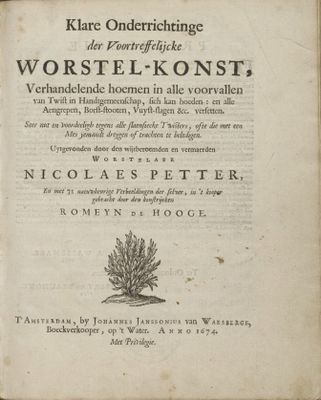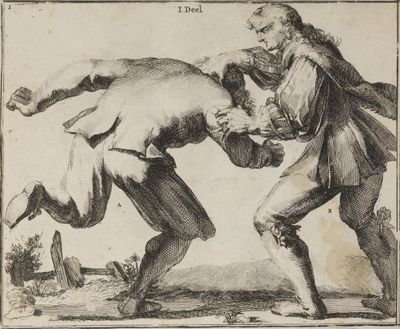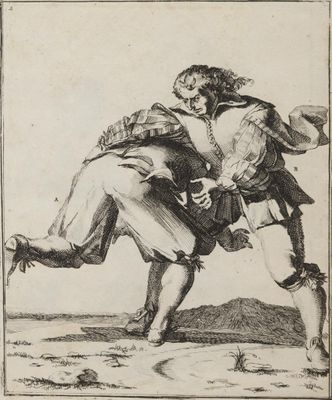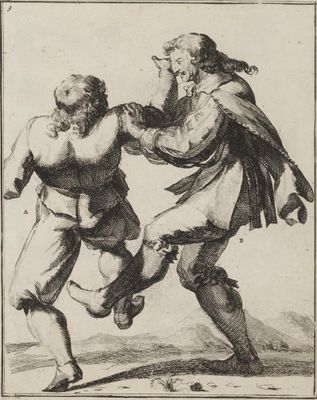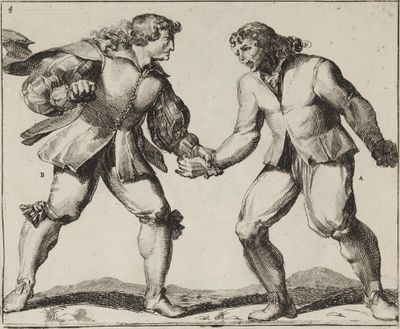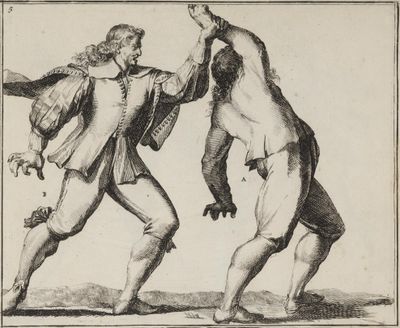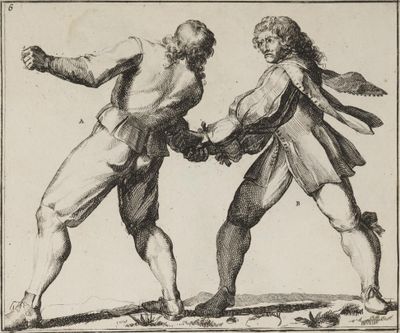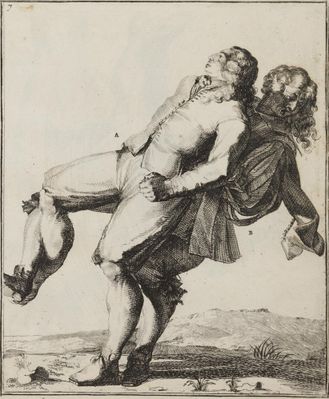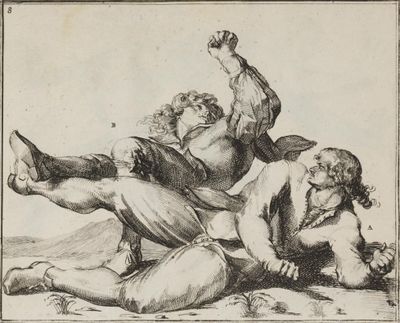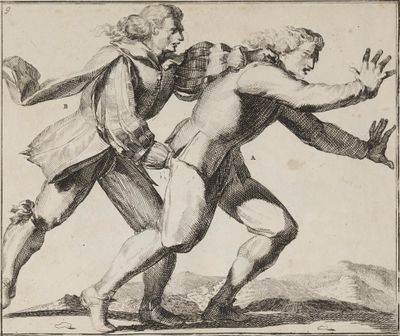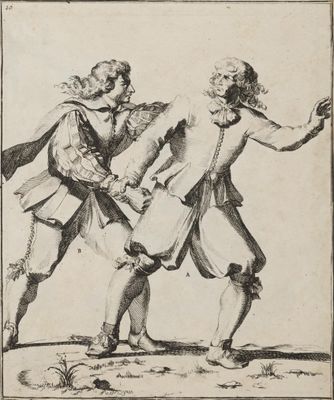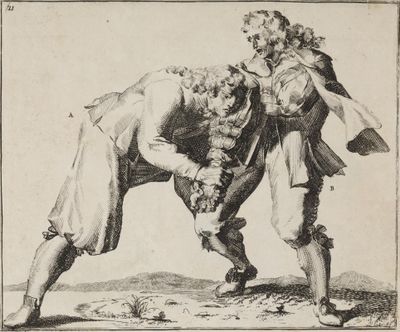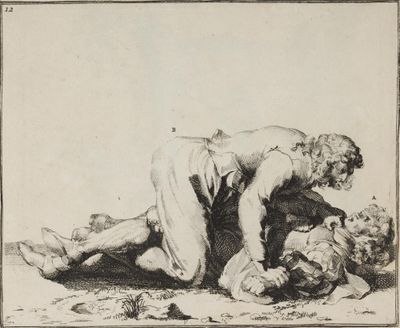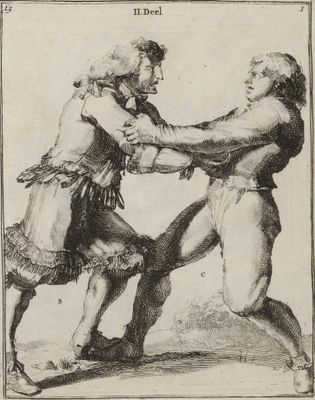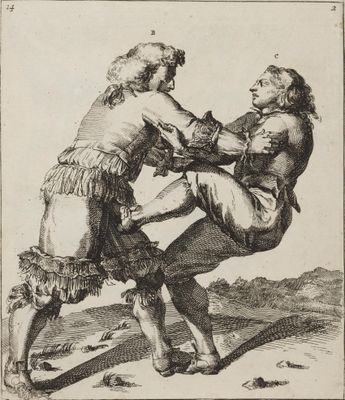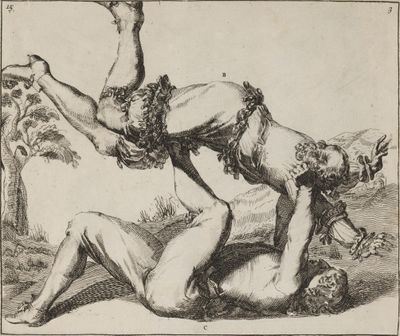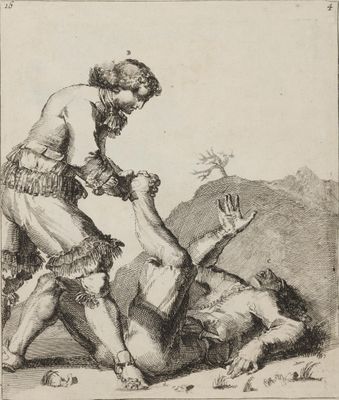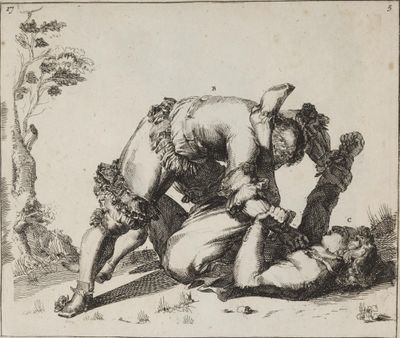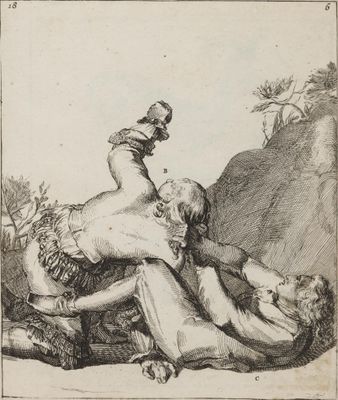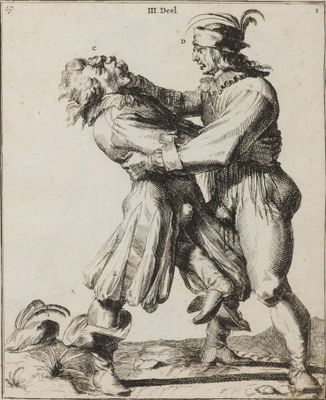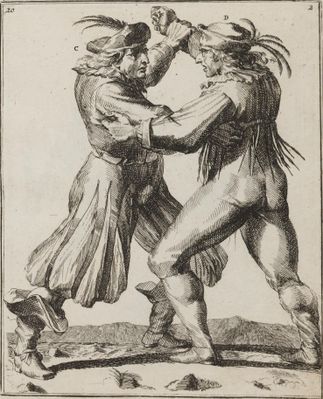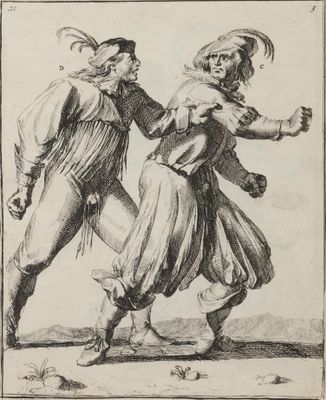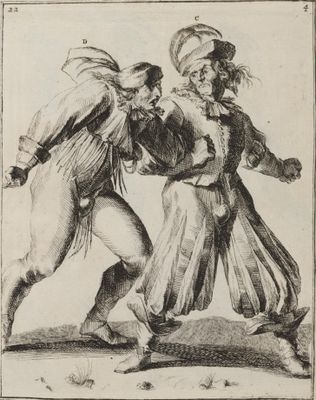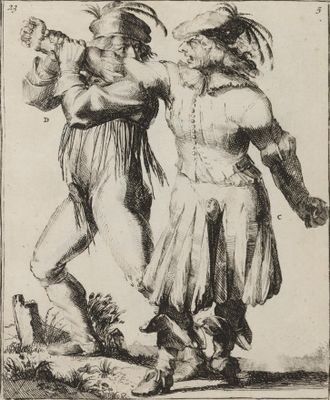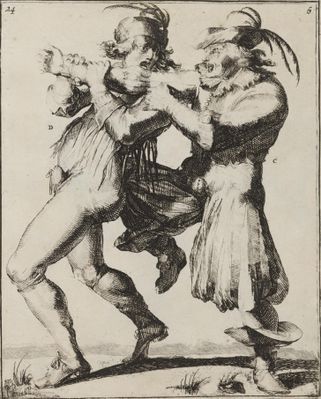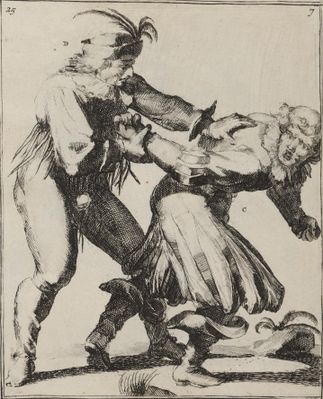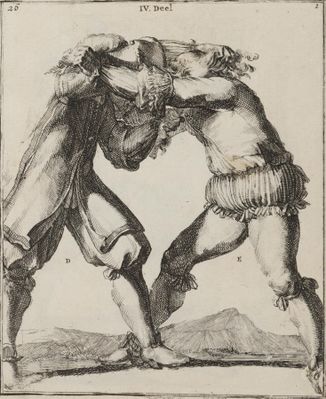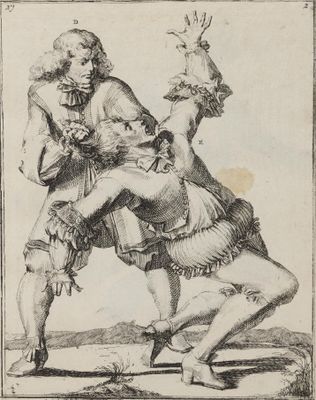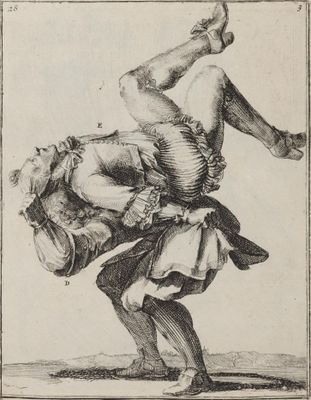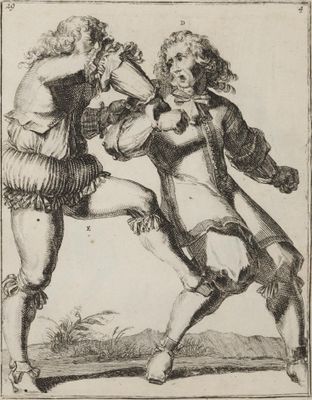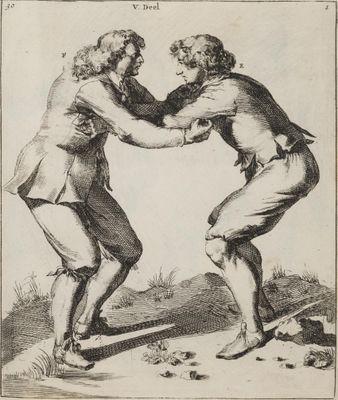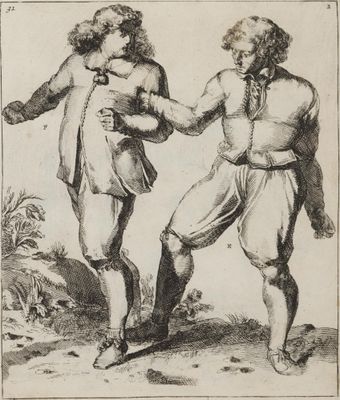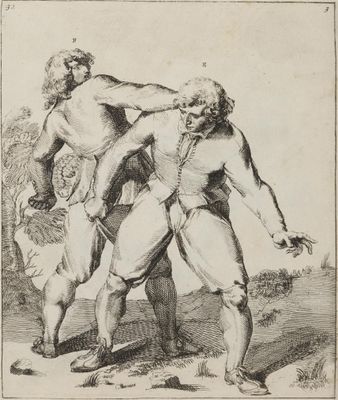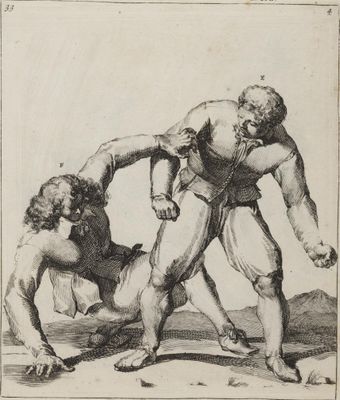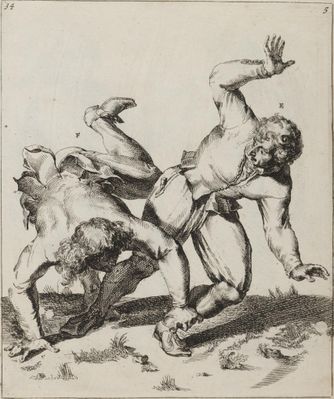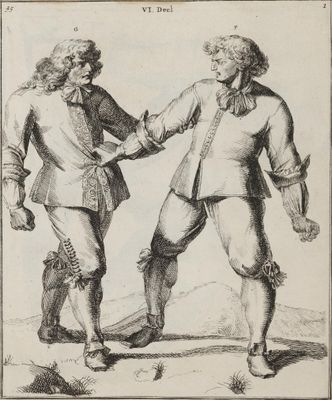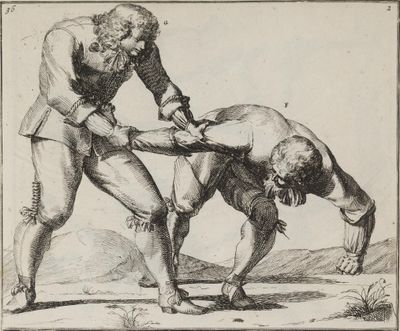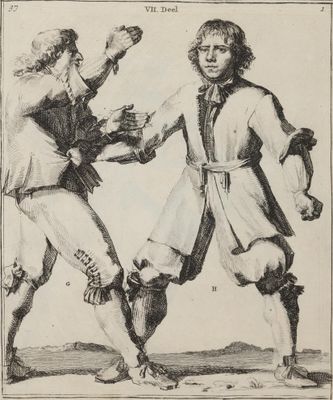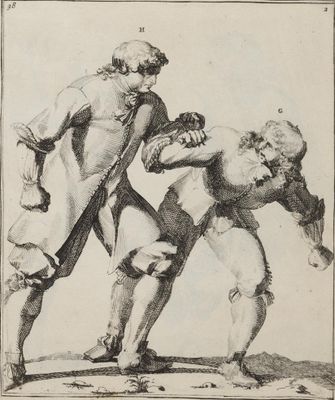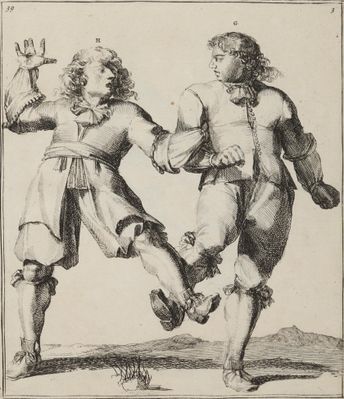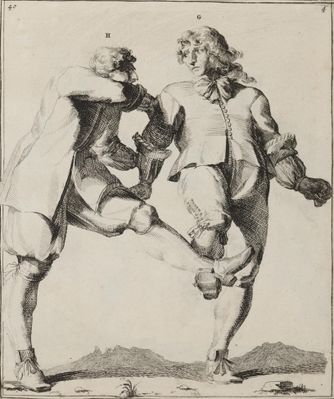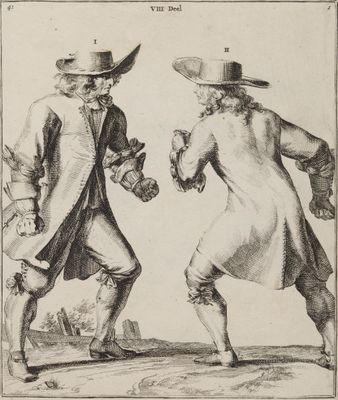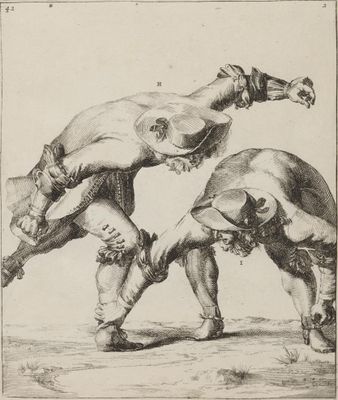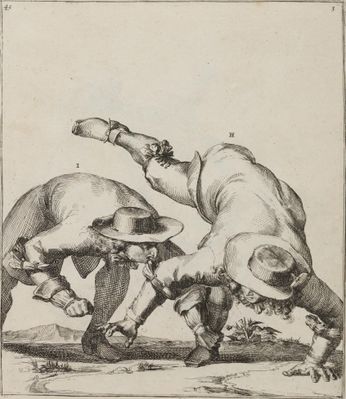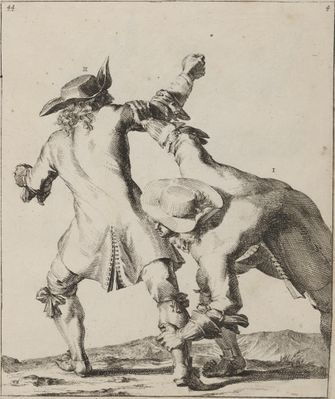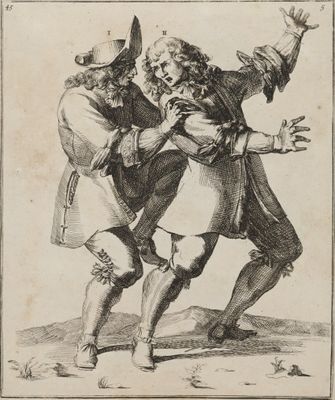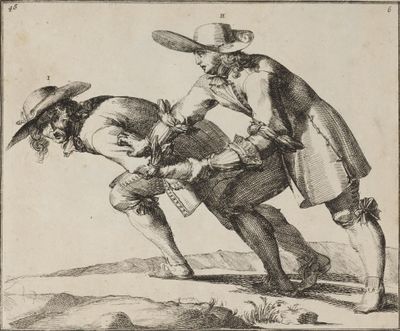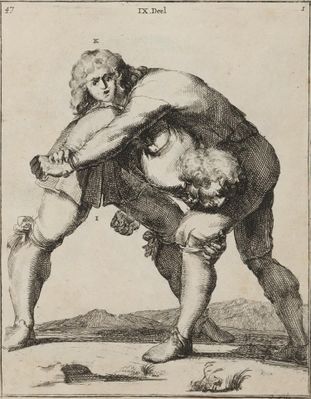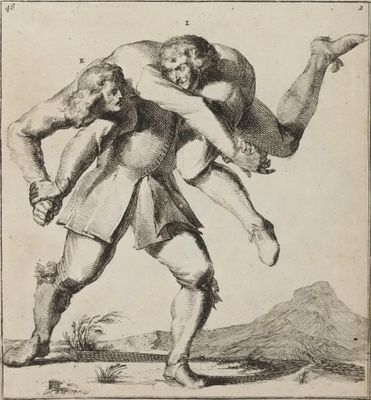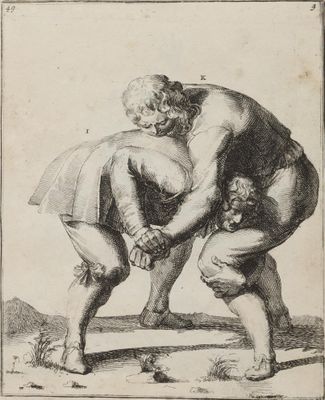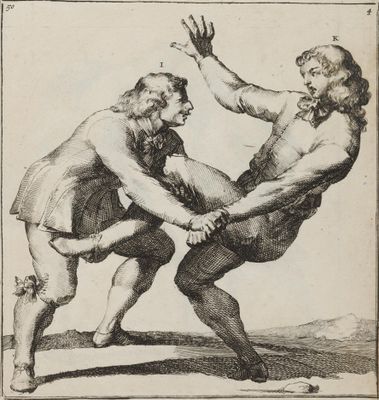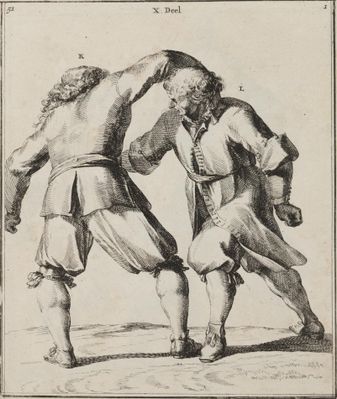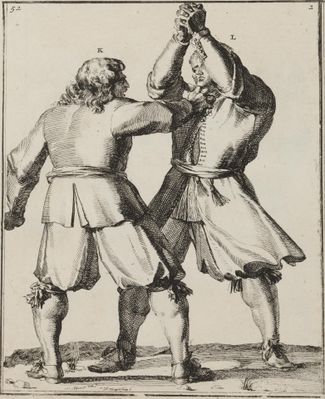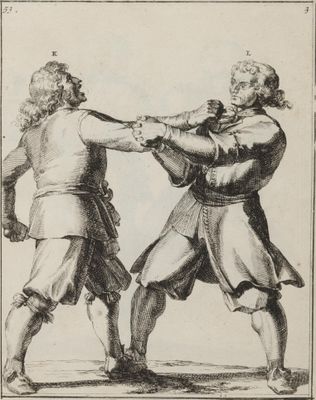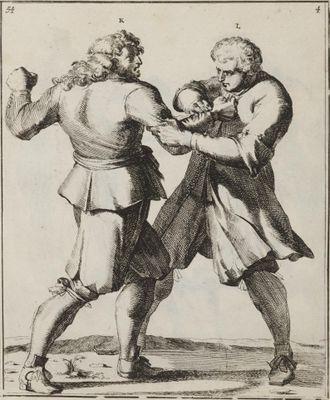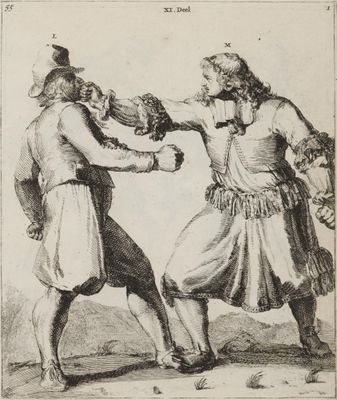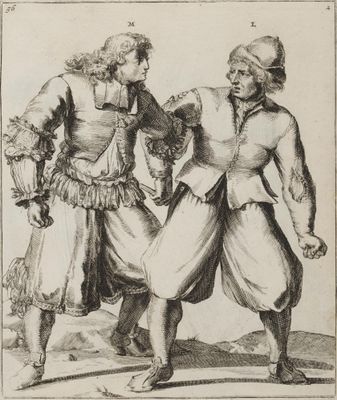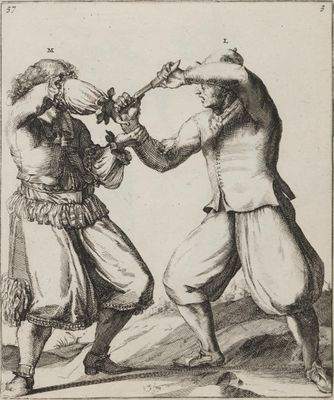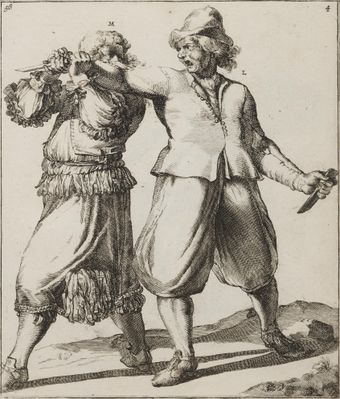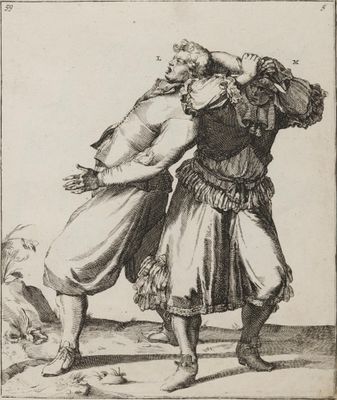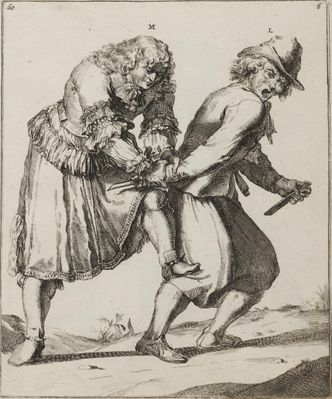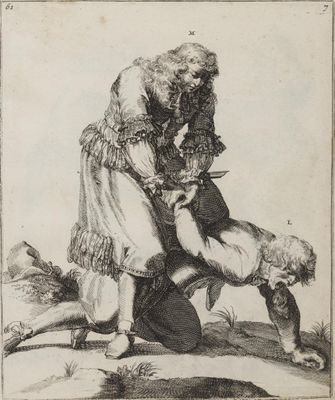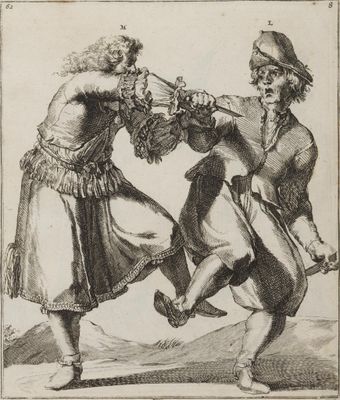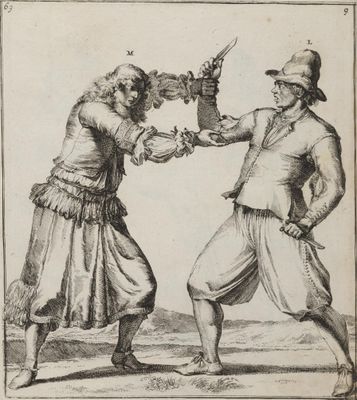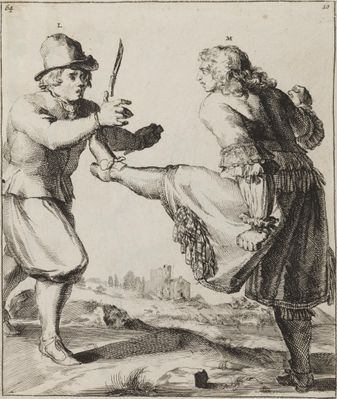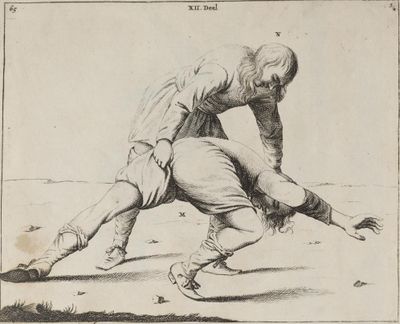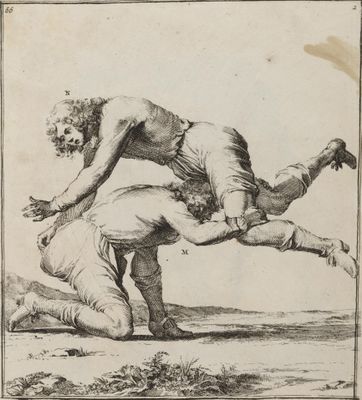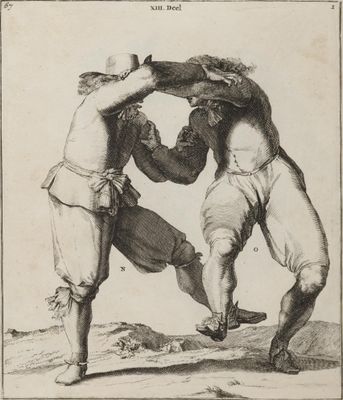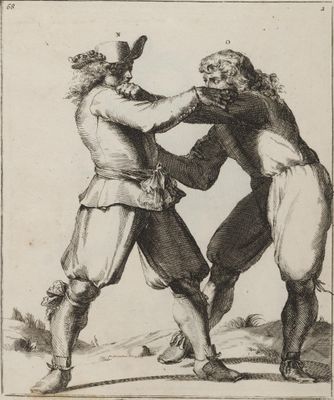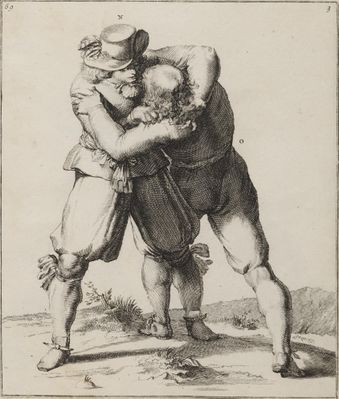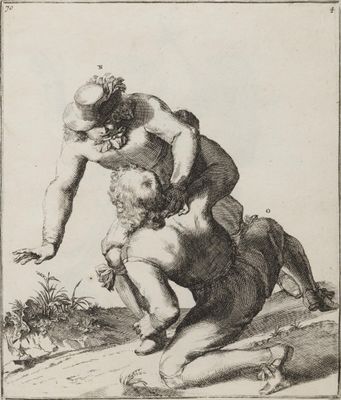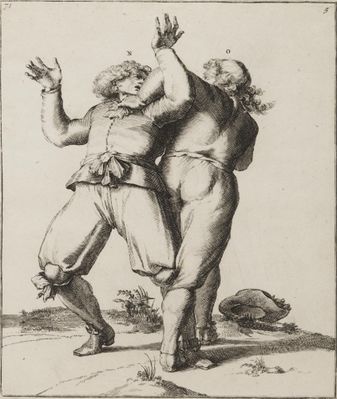|
|
You are not currently logged in. Are you accessing the unsecure (http) portal? Click here to switch to the secure portal. |
Nicolaes Petter
| Nicolaes Petter | |
|---|---|
| Born | 1624 Mommenheim |
| Died | 1672 (aged 48) Amsterdam |
| Resting place | Leidsche Kerkhof, Amsterdam |
| Occupation |
|
| Nationality | German |
| Genres | Wrestling manual |
| Language | Dutch |
| Notable work(s) | Klare Onderrichtinge der Voortreffelijke Worstel-Konst (1674) |
| First printed english edition |
Blanes 2011 |
| Concordance by | Michael Chidester |
| Translations | Deutsch-Übersetzung |
| Signature | |
Nicolaes Petter (1624 – 1672) was a 17th century German wine merchant and wrestling master. He was born in Mommenheim, Germany, and took on an apprenticeship in Amsterdam, Netherlands as a young man.[citation needed] He then joined the wine guild and went on to become a successful wine merchant. Petter practiced a style of grappling known as luctorius, and was known in his time as an undefeatable wrestler.[citation needed] His clientele seems to have consisted mostly of upper-class gentlemen, and the techniques he taught were considered more "civilized" than common wrestling.[citation needed]
Petter wrote an extensive treatise on grappling as a means of urban self-defense titled Klare Onderrichtinge der Voortreffelijke Worstel-Konst ("Clear Education in the Magnificent Art of Wrestling"), but did not publish it before his death in 1672. His widow inherited the manuscript and published it with illustrator Romeyn de Hooghe in 1674,[citation needed] and it was reprinted and translated many times in the following centuries. Sydney Anglo describes this text as "historically speaking, [one of] the [two] most important treatises on unarmed combat ever printed", and notes that "in many ways, the finest of all wrestling books—and deservedly the most famous—was the treatise by Nicolaes Petter and Romeyn de Hooghe".[1]
Contents
- 1 Treatise
- 1.1 Preface
- 1.2 The First Part
- 1.3 The Second Part
- 1.4 The Third Part
- 1.5 The Fourth Part
- 1.6 The Fifth Part
- 1.7 The Sixth Part
- 1.8 The Seventh Part
- 1.9 The Eighth Part
- 1.10 The Ninth Part
- 1.11 The Tenth Part
- 1.12 The Eleventh Part
- 1.13 The Twelfth Part
- 1.14 The Thirteenth Part
- 1.15 Copyright and License Summary
- 2 Additional Resources
- 3 References
Treatise
Illustrations |
Klare Onderrichtinge der Voortreffelijke Worstel-Konst |
Der künstliche Ringer... |
L’Académie de l’admirable art de la Lutte | |
|---|---|---|---|---|
| Klare Onderrichtinge der Voortreffelijcke WORSTEL-KONST, Verhandelende hoemen in alle voorvallen van Twist in Handtgemeenschap, sich kan hoeden: en alle Aengrepen, Borst-stooten, Vuyst-slagen &c. versetten. |
L’ACADEMIE DE L’ADMIRABLE ART de la LUTTE Montrant d’une maniere très exacte non seulement la force extraordinaire de l’Homme, mais aussi les mouvemens merveilleux, l’usage singulier, & les souplesses des principales parties ou membres du corps humain. | |||
| Seer nut en voordeeligh tegens alle slaensiecke Twisters, ofte die met een Mes yemandt dreygen of trachten te beledigen. | Avec une instruction claire & familiaire, comment on peut en toutes les occasions repousser sûrement & adroitement toutes sortes d’Insultes & d’Attaques. | |||
| Uytgevonden door den wijtberoemden en vermaerden
WORSTELAER NICOLAES PETTER, |
||||
| En met 71 naeuwkeurige Verbeeldingen der selver, in ‘t kooper gebracht door den konstrijcken
ROMEYN DE HOOGE |
Representée en soixante & onze tailles douces, qui sont très belles, & qui ont été dessinées par le Celebre & Fameux
Mr. ROMEIN DE HOOGUE. | |||
| Ouvrage non seulement des plus agréables & des plus necessaires pour toute sorte de Personnes, mais aussi très utile pour bien connoître les mouvements & les souplesses du corps humain. | ||||
| On trouvera à la fin de l’Ouvrage des Tables, qui expliquent clairement & distinctement toutes les tailles douces. | ||||
| T'AMSTERDAM,
by JOHANNES JANSSONIUS van WAESBERGE, Boeckverkooper, op 't Water. ANNO 1674. Met Privilegie. |
A LEIDE
Chez ISAAC SEVERINUS,
Marchand Libraire. | |||
| PRIVILEGIE.
De Staten van Hollandt ende West-Vrieslandt, Doen te weten: Alsoo ons vertoont is by Joannes Janssonius van Waesberge, Boeckverkooper, woonende tot Amsterdam, dat hy Suppliant, met groote kosten, gedruckt hadde twee boecken, zijnde het eene geintituleert Korte ende Bondige Instructie van de Regulare en Irregulare Fortificatien. Nevens een nieuwe Manier der selver, beschreven door de Mrs. Gerard Melder, ende Pieter Becker: ende het andere Klare Onderrichtinge der voortreffelijcke Worstel-konst, door Nicolaes Petter, waer van de gedruckte Tijtels ons zijn geexhibeert, en naerdemael den Suppliant groote kosten hadde gesupporteert tot het voltrecken van de voorsz. respective Boecken, en beducht was dat deselve door eenigh nydigh of baetsoeckent mensche hem mochten werden nagedruckt, waer door den Suppliant van sijne exceßive onkosten soude werden gesrustreert, soo keerde hy hem selven aen Ons, ootmoedelijck versoeckende, dat het Onse goedertierene geliefte mochte wesen hem Suppliant te verleenen Octroy, voor den tijdt van vijftien achter-een-volgende Iaren, omme de voorsz. respective Boecken alleen te mogen Drucken, ende dat in soodanige Talen als de Suppliant bevinden soude hem oirbaerlijck te zijn. Soo is ‘t, dat wy de sake en ‘t Versoeck voorsz. overgemerckt hebbende, ende genegen wesende ter bede van den Suppliant, uyt onse rechte wetenschap, souveraine macht en autoriteyt, den selven Suppliant geconsenteert, geaccordeert ende geoctroyeert hebben, consenteren, accorderen en octroyeren midts desen, dat hy, geduerende den tijdt van vijftien eerst achter-een-volgende Iaren, de voorsz. Boecken, in soodanige Talen als hem goedtduncken sal, binnen den voorsz. onsen Lande, alleen sal mogen Drucken, uytgeven en verkoopen; verbiedende daerom allen ende eenen yegelijcken deselve Boecken na te drucken, ofte elders naergedruckt binnen den selven Onse Landen te brengen, uyt te geven ofte te verkoopen, op verbeurte van alle de naergedruckte, ingebrachte, ofte verkochte Exemplaren, ende een boete van drie hondert guldens daer en boven te verbeuren, te appliceren een derde part voor den Officier die de Calange doen sal, een derde part voor den Armen der Plaetse daer het Casus sal voorvallen, ende het resterende derde part voor den Suppliant. Alles in dien verstande, dat wy den Suppliant met desen Onsen Octroye willende gratificeren, tot verhoedinge van sijne schade, door het nadrucken van de voorsz. Boecken, daer door in eenigen deelen verstaen, den inhoude van dien te autoriseren ofte te avoueren. Ende veel min deselve onder Onse protectie ende bescherminge, eenigh meerder credit, aensien ofte reputatie te geven, nemaer den Suppliant, in cas daer in yets onbehoorlijcks soude mogen influeren, alle het selve tot sijnen laste sal gehouden wesen te verantwoorden, tot dien eynde wel expresselijck begeerende, dat by aldien hy desen Onsen Octroye voor deselve Boecken sal willen stellen, daer van geene geabbrevieerde ofte gecontraheerde mentie sal mogen maken, nemaer gehouden sal wesen het selve Octroy in ‘t geheel, ende sonder eenige omißie daer voor te drucken, op pæne van het effect van dien te verliesen. Ende ten eynde den Suppliant desen Onsen Consente ende Octroye moge genieten als na behooren, lasten Wy allen en eenen yegelijcken die ‘t aengaen mach, dat sy den Suppliant van den inhoude van desen doen laten en gedoogen, rustelijck, vredelijck ende volkomentlijck genieten en gebruycken, cesserende alle belet en weder seggen ter contrarie. Gedaen in den Hage, onder onsen Grooten Zegel hier aen doen hangen, den 12.Februarii in ‘t Iaer onses Heeren ende Salighmakers duysent ses hondert vier en seventigh. vt. Ter Ordonnantie van de Staten. |
||||
| PREFACE
Wherever the considerations of even the most sensible were brought, concerning the memoirs of the past centuries as those of nowadays; as under the deepest astonishment, they never return. Experience provided a lot of arts to the World; and by practise gave birth to sciences, especially when a diligent and acute brain gets involved. Practice must complete the art; because it is not enough just to understand something with ones ingenuity, only he who is practiced can become a Master. Further, education should bring the art among people and make it general, otherwise, it would once again die with the one who had found it. The arts then demand time, diligence, exercise, education, and this with ingenuity in order to give it its own Being and beautification. Thus, the always-working intellect, continuously fed by exercise and diligence, can bring men lots of useful astonishment and contentment. Apelles will only have brought his paint and brush to his aid whilst imitating Nature so wonderfully; that Nature itself, in reproducing its own Being, seemed to have borrowed the image of that what was reproduced by Apelles himself. The chisel only might serve another artist, who, guided by his practised mind, images in a stone that being of Nature, that Nature itself would not be ashamed if it had been her own, yes, often, the perfection of forms in stones excels particularly. It’s true that Nature as a teacher educates daily through different incidents, but then there’s art, that displays the most perfect qualities. Quite some times we have to ascribe Her (Nature) with lots of privileges, and although Nature always strives to perfection, sincere perfection is found in the subject of Art. I’m not trying to shame Nature, withdraw her the result of the most perfect form, since we keep wondering about all her ways, but in fact I want to bring forward the nature of Art, and through that, promote her esteem. For this purpose it should be researched accurately, diligence should be encouraged and astonishment accomplished. The forces given to men by Nature aren't equal in everyone, and though they were found equal, they couldn’t be exerted against each other because fluency will leave one of them a master, even more if that fluency is based on knowledge. Many have left their concern to protect themselves in the best way against insulting incidents, especially those quarrelsome, when this might happen by wanton villains. With this in mind, our Wrestler steadily sharpened his mind, in order to invent capable grips, through which one can defend against wanton pushes, punches, knife attacks and ward them all dexterously. In these he practised continuously: and in that the world might be served usefully, he finally decided to bring out this Wrestling book: but the envious Death took him from us before his time, and before he could do what he decided to do. Thought, because he had the plates already made during his life, and since they were put in convenient sequences with a short description to teach the studious Wrestler, we no longer wanted to hide this excellent useful science, and encouraged by many enthusiasts, yet also for the promotion of general use, defence, and prevent wanton fight sick villains, we communicate this work to the world. Receive thus with willing gratitude, this new, excellent and very useful Art, wherein no one should remain ignorant. Start to learn and practice these techniques with diligence, you will never pity the effort, but enjoy the fruits of your labour in that you will easily ward and control fight-sick troublemakers, in that all who know nothing about your reasonable protection will highly wonder, and you will be able to move easily among people without being insulted. |
VOOR-REDEN
WAer d’overdenckingen van de Verstandighste selfs, ontrent de Gedenkschriften, soo van de voorledene eeuwen, als van dese tegenwoordige, wierden heen gevoert, van daer keerden sy noit weder, als onder de diepste verwonderingen. d’Ervarentheit heeft vele konsten aen de werelt verschaft; en deselve neerstighlijck geoeffent, heeft soo vele Wetenschappen gebaert, voornamelijk wanneer een scherpsinnigh brein daer nevens gekomen is. D’oeffening moet de konst voltoien; want het is niet genoech eenige saek door een snedigh vernuft te hebben begrepen, maer die sich geoeffent heeft, kan alleen daer Meester in zijn. Daer by moet d’onderwysing dan komen, om de konst onder de menschen gemeen te maken, of anders sou die weder moeten sterven, met den genen die haer gevonden had. Tot de konsten dan werden de tijdt, neerstigheit, oeffening, onderwysing, met een schrander vernuft vereist, om daer aen haer eigentlijk wesen, en de noodige optoisels te geven; dus kan het altijt werckend verstant, door oeffeningen en neerstigheden geduurigh gevoed, aen de menschen veel verwondering en vernoeging nuttiglijk toebrengen. Apelles sal alleen de verw en ‘t pinceel tot hulp genomen hebbende, door sijn geoeffent vernuft de Natuur so heerlijk nabootsen, dat de Natuur selfs, in ‘t voorbrengen van het felfde wesen, de gedaente van dat voortgebrachte van Apelles ontleent schijnt te hebben. Aen een ander konstenaer sal alleen de beitel konnen dienen, door sijn geoeffende geest bestiert, om aen de steen dat wesen der Natuur uitwendig te geven, dat de Natuur selfs sich niet sou hebben te schamen, indien het van haer was geteelt; ja dikwils sal de volmaektheit der gedaenten in de Steenen bysonderlijk uitmunten. Het is wel waer, dat de Natuur als Leer-meestersse dagelijks door allerhande voorvallen onderwijst, maer dan komt ook de Konst eerst de volmaekste hoedanigheden daer in vertoonen; ja aen haer moet veeltijts soo veel voorrecht worden toegeschreven, dat of schoon de Natuur altijt na het volmaekste tracht, d’oprechte volmaektheit eerst in het onderwerp van de Konst wort gevonden. Ik ben niet gesint de Natuur te beschamen, met haer d’uitwerking der volmaekste gedaentens t’ontrecken, daer wy ons gestaeg over alle hare werckingen ten hoogsten blyven verwonderen; maer eigentlijk den aert van de Konst voor te dragen, en hare achting daer door te bevorderen. Hier toe moet sy van yder naeuwkeurigh ondersocht, den yver aengeport, en de verwondering voldaen worden. De krachten door de Natuur aen ‘t menschelijck geslacht toegevoeght, zijn in alle niet even gelijk, en schoon die in evengelijkheidt wierden bevonden, soo souden sy nochtans soodanigh tegen malkander niet ingespannen konnen worden, of de geswintheit sal echter een van beiden meester laten blyven, te meer als die geswintheidt op kennis gegrondvest mach zijn. Vele hebben hare bekommering laten gaen, om sich op het sekerste tegen alle beledigende voorvallen te beschermen, insonderheidt, de twist-sieckte uitgebannen zijnde, indien door moedwillige booswichten haer die mochten overkomen. Op dit insicht heeft onse Worstelaer sijnen geest staegh gescherpt, om bequame streken en handtgrepen uit te vinden, waer door men sich tegen moedwilligh bespringen van stooten, vuist-slagen, of anders van een mes kan verdedigen, en alle quaedt behendigh af keeren. Hier in heeft hy sich selven geduurigh geoeffent: en op dat de wereldt daer van nuttighlijk sou konnen gedient worden, soo heeft hy eindelijck besloten dit Worstelboek in het licht te geven: maer de nydige Doot heeft ons hem ontydigh komen ontrucken, eer dat hy sijn besluit kon voltrecken. Doch dewijl hy dese Platen in sijn leven al had laten maken, en de selve in dese bequame ordre geschickt, met een korte beschryving om den leer-gierigen Worstelaer t’onderrichten, soo hebben wy dese voortreffelijcke nutte Wetenschap niet langer verborgen willen houden, insonderheidt door ontallijke Liefhebbers krachtig daer toe aengeport, maer de selve tot bevordering van d’algemeene nuttigheit, het tegengaen en beletten van alle moedwillige veght-siecke boos-doenders, aen de wereldt willen mede deelen. Ontfangt dan met goetwillige danckbaerheidt, dese so wel nieuwe, als uitstekende en seer dienstige Konst, waer in geene menschen behoorden onwetende te willen blyven. Begeeft u tot dese handtgrepen vlytigh te leeren en te oeffenen, ghy sult uwe moeiten nimmer konnen beklagen, maer daer van soodanige goede vruchten genieten, dat ghy alle twist-en veght-sieke moeite-makers lichtelijck sult konnen afkeeren en bedwingen, soo dat alle onwetende over uwe redelijcke bescherming sich ten hoogsten sullen hebben te verwonderen, en ghy allesins onbeledight en gerust onder de menschen sult konnen verkeeren. |
PRÉFACE
C’est une chose assez connue, que l’Experience a fait paraître dans le monde divers Arts ; et qu’ayant été poussée plus loin par un exercice continuel elle a produit quantité de Sciences. Et certainement les Arts doivent se perfectionner par la pratique : car ce n’est pas assez d’avoir compris quelque chose par son esprit subtil et pénétrant, mais celui-là seul peut passer pour maître en ceci qui s’y est bien exercé. En suite de quoi doit venir l’instruction pour rendre l’Art commun entre les hommes, ou autrement il devrait mourir avec celui qui l’avait inventé. De sorte que pour l’accroissement et la perfection des Arts et des Sciences il faut du temps, de la diligence, de l’exercice, de l’instruction, et un esprit pénétrant, afin de les faire paraître dans leur naturel et dans tous leurs ornemens. De cette manière l’intelligence de l’homme peut donner bien de l’admiration et de la satisfaction. Apelles ayant employé utilement le coloris et le pinceau imitera si noblement la Nature par son esprit pénétrant et appliqué, que la Nature elle-même semblera avoir emprunté la figure d’Apelles dans la production de ses propres ouvrages. Le ciseau ne pourra servir à un autre Ouvrier que pour donner extérieurement à la pierre la forme de la Nature, que la Nature ne prendrait point à honte, si elle l’avait produit ellemême. Il est bien vrai que la Nature comme un Pédagogue instruit par toute sorte d’objets ; mais ensuite l’Art y vient représenter les qualités les plus parfaits ; jusque-là qu’on doit attribuer quelque fois à l’Art un si grand privilège, que bien que la Nature tâche toujours d’atteindre à ce qui est le plus parfait, la véritable perfection se trouve principalement dans le sujet de l’Art. Je n’ai pas dessein de faire honte à la Nature, mais uniquement de mettre devant les yeux le propre de l’Art, et par-là de la faire estimer. Les forces de la Nature dans l’homme ne sont pas toutes égales, et quoique cela fut ainsi, cependant elles ne s’uniraient point si bien entre elles, que la vitesse ou l’adresse ne fit triompher l’un des deux, d’autant plus que cette adresse est fondée sur une connaissance certaine. Plusieurs ont fait tous leurs efforts pour se défendre de la manière la plus sûre contre toutes les attaques et les insultes des méchants garnements. Dans cette vue ce célèbre Auteur, dont on n’a jamais vu son pareil dans le monde, a appliqué son esprit pour trouver de bons tours d’adresse et de souplesse, par lesquels on peut se défendre contre toutes sortes d’insultes, contre les coups de Pied ou de Poing, et même contre les coups de Couteau, et détourner adroitement toutes sortes de maux. En quoi il s’était si bien perfectionné par un exercice continuel, que sur les instantes prières de plusieurs Curieux, et pour être utile au public, il résolut enfin d’employer ses soins à proposer de la manière la plus claire cet admirable Art et à en faire part au Public. Pour exécuter son dessein le mieux qu’il lui serait possible, il a eu soin de rechercher un bon Ouvrier, et pour cela il s’est servi de la main du célèbre Romeyn de Hooghe, qui a su plaire aux Rois et aux Princes mêmes par ses découvertes et par ses entreprises aussi bien que les plus habiles Maîtres ; de sorte que cet Ouvrage inventé et executé par un Ouvrier aussi illustre est parfait en toutes ses parties. Or pour faire comprendre clairement toutes ces choses il a ajouté ici une claire et nécessaire description et explication de toutes les belles Tailles douces dans les Tables suivantes, afin qu’un chacun pût de lui-même par la pratique apprendre cet Art utile et avantageux, et y devenir maître, que personne ne devrait ignorer pour mettre à couvert son Corps et sa Vie. A quoi aidera aussi l’arrangement convenable de toutes les parties ; et on fait voir par la suite exacte des tailles douces ce qui est necessaire et utile par rapport à chacune en particulier. Et afin que personne ne puisse se tromper dans les Lutteurs qui y sont representés, on les trouvera distingués et marqués par les lettres A et B, B et C, et ainsi des autres ; et d’autant que le changement donne du plaisir, l’A est quelquefois le vainqueur, et quelquefois le B. Les differents habillements, avec lesquels nos Lutteurs sont representés dans ces Tailles douces, les distinguent suffisamment ; d’autant que l’on voit dans chaque partie des ajustemens différents, par où les gens de bon goût ne pourront point se tromper. Servez-vous donc de cet Art quand il en sera besoin pour votre avantage. Adieu, et prenez du plaisir. | ||
| Aen de LIEFHEBBERS Van de WORSTEL – KONST.
WAerde Gunstelingen, dese Konst wort u E. soodanigh opgedragen, dat al het gene, wat ghy daer ontrent mooght vereisschen, genoeghsaem bekent kan wesen. Ghy hebt hier een seer bequame schicking van alle de Deelen; en wat bewercking ontrent yder in ‘t bysonder noodigh is, wort door de naeuwkeurige vervolging der Platen aengewesen; en op dat niemandt in de afgebeelde Worstelaers mocht komen te verwerren, soo zijn die door A en B, B en C, C en D, en soo voorts, alle onderscheiden en geteeckent: En terwijl de verandering aengenaem is, en vermaeck aenbrengt, soo is somtijts A, en dan wederom B overwinnaer. D’onderscheide Kleedingen, waer mede onse Worstelaers in dese Platen zijn afgemaelt, wijst oock genoechsaem der selver onderscheidt aen; soo dat yder Deel sijn bysonder gewaed heeft, waer door de naeuwkeurige Liefhebbers hier niet lichtelijck sullen konnen dwalen. Indien sommige belust mochten wesen, om dese Worstelingen in ‘t werck gestelt te sien, of in dese Lessen met‘er daedt klaerder onderwesen te worden, die konnen daer toe geraken door den Leerling van Nicolaes Petter zal. Robbert Cors, die alle dese Grepen menighmael met den Autheur selfs ge-exerceert heeft, gelijck hy gewilligh is om voor redelijck loon deselve Lessen by de Liefhebbers te exerceren. Hy is hier te vinden ten huise van de Weduwe van Nicolaes Petter voornoemt, op de Prince-gracht, in Gustavus-burgh, niet wijd van het Scherm-School; waer alle, die dese heerlijcke nutte Konst beminnen, haer volkomen vernoegen sullen krygen, en sich dierhalven konnen bedancken. Gebruickt dan dese Konst tot u voordeel, en laet de geheughnis des genen die u deselve gegeven heeft, altijt onder u E. danckelijck in goede achting en waerde gehouden worden; soo sal men hier na noch andere geesten konnen ontmoeten, die door haer vernuft deselve Konst met meer nieuwe Grepen sullen verrijcken. Vaer wel. |
||||
| Clear Education in the Magnificent Art of Wrestling
|
Klare Onderrichtinge der voortreffelijcke WORSTEL–KONST.
TErwijl gewoonlijck, en voornamentlijck ontrent de Hollanders, gebruyckelijck is, waer eenige twist of tweedracht tusschen eenige Persoonen geresen mach zijn, die soo hoogh komt te klimmen dat de Handtgemeenschap daer op volght, dat sy malkander op de Borst stooten, als de wegh zijnde, waer door men tot de heviger Vuystslagen gaet: soo hebben wy van de Borst-stooten hier het beginsel willen nemen, als zijnde den eygentlijcken aenvangh om de twist door hantgemeenschap wacker te maken: en voorts sullen wy alle grepen met order vervolgen. |
EXPLICATION des FIGURES. |
Illustrations |
Klare Onderrichtinge der Voortreffelijke Worstel-Konst |
Der künstliche Ringer... |
L’Académie de l’admirable art de la Lutte | |
|---|---|---|---|---|
| No. I. About chest punches
|
N°. 1. Van de Borst-stooten.
|
Pag.1. No.1. De la maniere de se porter des Coups contre la Poitrine.
Lorsque A veut donner un coup a B sur la poitrine, B peut en se retirant un peu a l’ecart faire manquer son coup a A, par où A etant obligé de pencher la tête apres le coup manquè, il donne le temps a B de saisir A par derriere vers la nucque, par ou B poussant ainsi A en bas, il faut que A tombe la tête la premiere. | ||
| 2. Chest punch in a different way
A hits B on the chest. After being hit, B twists his left or right leg, depending on where the punch is coming from, around the right or left leg of person A. He then pushes with his left hand A's right arm downwards and with his left hand he grabs A behind his buttocks at his trousers. Doing this, A has to fall over the leg that B has put forward. |
2. Borst-stoot op een andere wijse.
A geeft aen B een Borst-stoot, B soo haest dese stoot ontfangt, slingert sijn rechter of slincker been, na de stoot komt, om het rechter of slincker been van A, en druckt met sijn slincker handt de rechter arm van A nederwaerts, met de rechter hant grijpt B A achter by de Billen op de Broeck, en dit soo doende moet A nootsakelijck vallen over het been van B dat voor uyt staet. |
Pag.2. No.2.
AUTRE MANIERE. A donne un coup à B sur la poitrine, & B n’a pas plûtôt reçú le coup qu’il tourne sa jambe droite ou gauche, selon que le coup vient, autour de la jambe droite ou gauche d’A, & presse en bas avec sa main gauche le bras droit d’A, & B prenant A par derriere vers les fesses par-dessus la culotte, A doit necessairement tomber par-dessus la jambe de B, qui s’avance en dehors. | ||
| 3. In a different way
A hits B on the chest. Seeing this, B takes A's right arm under A's armpit with his left hand and with his right hand B grabs A's left wrist. By putting his left leg behind A's right leg, B can then make A fall backwards. |
3. Op een ander wijse.
A geeft B de Borst-stoot, B dit siende, vat den rechter arm van A met sijn slincker hant van onderen onder de Oxel, en vat met sijn rechter handt de slincker Pols van A, slaende met eenen geswindelijck sijn slincker been om het rechter been van A, en dwingt hem alsoo achter over te vallen. |
Pag.3.No.3.
AUTRE MANIERE. A porte un coup à B sur la poitrine, B voyant cela empoigne avec sa main gauche le bras droit d’A par dessous l’aisselle, & prend avec sa main droite le pouls gauche d’A, mettant tout d’un temps fort agilement sa jambe gauche contre la jambe droite d’A, & l’oblige ainsi de tomber à la renverse. | ||
| 4. In a different way.
A hits B on the chest. B grabs A on the wrist with such a formidable power thus trying to twist the arm. |
4. Op een andere wijse.
A geeft aen B de Borst-stoot, B vat A met een bysondere kracht op de Pols, dien hy soodanigh tracht den arm te verdraeyen. |
Pag.4.No.4.
AUTRE MANIERE. A donne un coup à B sur la poitrine, B prend avec une extreme force A vers le poignet, & il tâche de lui tordre le bras. | ||
| 5.
Because A may try to resist to this, he turns under B's arm thus trying to get loose. |
5.
Om dat A dit voorgaende mocht versetten, soo kruypt hy onder den arm van B door, soeckende alsoo los te geraken. |
Pag.5.No.5.
MANIERE POUR PARER CE COUP. Afin qu’A puisse parer ce coup, il passe par-dessous le bras de B, & tâche ainsi de se debarrasser. | ||
| 6.
When A is turning under B's arm, B takes A's hand (the wrist of which he had taken with his left hand) and pushes it behind A's back. This gives B the opportunity to actually brake A's hand. |
6.
In het voorgaende onder door kruypen van de arm van B, soo vat B terstont met beyde sijne handen, die hant van A, welckers Pols hy van te voren met sijn slincker hant had gegrepen, en brengtse of dwingtse achter op den rugh van A, waer door dat B gelegentheyt krijght om de hant van A bequaemlijck te breken. |
Pag.6.No.6.
MANIERE DE SOUTENIR CE COUP. A ayant ainsi passé par-dessous le bras de B, B prend tout d’un coup avec ses deux mains la main d’A, dont il avoit pris auparavant le poignet avec sa main gauche, & les met par-dessus le dos d’A, par-où B trouve le temps de rompre fort à propos la main d’A. | ||
| 7. Resistance by A.
A steps back and puts his right leg around B's right leg. When A leans backward, both have to fall and A can then free himself. |
7. Een verset voor A.
A treet te rugh en slaet sijn rechter been om het rechter been van B, wanneer hy sich achter over begevende, sy beyde moeten vallen, en A soo komt los te raken |
Pag.7.No.7.
MANIERE DONT A DETOURNE CE COUP. A tourne le dos & met sa jambe droite contre la jambe droite de B, lorsque se laissant aller à la renverse, ils sont contraints de tomber tous deux, & par là A trouve moyen de se debarrasser | ||
| 8.
Then they lie fallen down because A twisted his leg around B's leg. |
8.
Dus liggen sy gevallen, door het omslingeren van het been van A, om het been van B. |
Pag.8.No.8.
MANIERE DONT ILS SONT COUCHEZ PAR TERRE. Ils sont ainsi tous deux couchez par terre, A ayant mis sa jambe autour de la jambe de B. | ||
| 9.
The one who stands up first, has the advantage to be able to grab the other at the collar with his left hand and at the trousers with his right hand. In this way, he can force the other person to walk forwards. |
9.
Die de eerste dan op is, heeft dit voordeel, dat hy de slincker handt kan slaen achter in de kraegh van d‟ander, en de rechter hant achter by de Broeck, dwingende hem, die soo gevat is, voor te loopen |
Pag.9.No.9.
AVANTAGE QU’A CELUI QUI SE RELEVE LE PREMIER. Celui donc qui est le prémier levé a cet avantage sur l’autre, qu’il peut mettre sa main gauche par derriere sur le collet de l’autre, & le prendre avec sa main droite par derriere la culotte, & l’ayant ainsi pris il le contraint de passer devant lui. | ||
| 10.
When B does such a thing, which has been shown in the previous picture, A can resist this in the following way. He moves his right hand backwards and takes B's right hand at the wrist, turning under B's arm. |
10.
Als B sulcks doet, gelijck hier in de vorige Plaet wort aengewesen, soo heeft A hier dit verset. Hy slaet sijn rechter hant achter om, en grijpt op de rechter Pols van de hant van B, sich met eenen onder sijn arm heen draeiende. |
Pag.10.No.10.
Lorsque B fait ce que l’on vient de voir dans la planche précedente, A trouve ce moyen de parer le coup: Il met sa main droite derriere lui, & prend le poignet droit de la main de B, se tournant dans le même temps sous le bras de B. | ||
| 11.
Having turned under B's arm, A pulls B's arm downwards and puts his left foot at B's knee. A can then push B with his head backwards and make him fall on his back as is shown in the next picture. |
11.
Hier onder den arm van B doorgedraeyt zijnde, treckt A den arm van B nederwaerts, en set sijn slincker voet achter op de knie kneep van B, hem stootende met sijn kop achter over, dat hy op de rugh neer valt, gelijck als in de volgende Plaet wort aengewesen. |
Pag.11.No.11.
A s’étant ainsi tourné par-dessous le bras de B, pousse en bas le bras de B, & met son pied gauche par derriere sur le jarret de B, le poussant avec sa tête par-derriere, de sorte qu’il tombe sur son dos, ainsi qu’on le void dans la planche suivante. | ||
| 12.
Thus being thrown down, and A lying on B's body, A grabs B with the left hand at the throat and keeps his right arm closed on the chest. With his right hand, A holds B's left hand on the ground and twists his leg around his leg. This prevents B from being able to get up. Lying on B, A can hit B on his face with left side of his head without any impediment |
12.
Aldus dan neder gesmeten zijnde, en A liggende op het lijf van B, grijpt hem met de slincker hant in de krop, en houd sijn rechter arm geslooten op de borst. Met de rechter hant houd A de slincker hant van B tegen de aerde aen, strengelt sijn beenen om sijne beenen, waer door dat B belet wort te konnen op staen, en A alsoo liggende kan aen B, sonder eenigh beletsel, met de zijde van sijn hooft, op het aengesicht van B, soo veel stooten als hy begeert. |
Pag.12.No.12.
B étant ainsi renversé par terre, & A étant couché sur le corps de B, il le saisit au gosier avec sa main gauche, & lui tient son bras droit serré sur la poitrine. Outre cela A tient avec sa main droite la main gauche de B contre terre, & il entrelasse ses jambes dans les siennes, par-où il empêche que B se puisse relever, & A étant ainsi couché sur B il peut facilement lui-donner sur le visage avec le côté de sa tête tout autant de coups qu’il veut. |
Illustrations |
Klare Onderrichtinge der Voortreffelijke Worstel-Konst |
Der künstliche Ringer... |
L’Académie de l’admirable art de la Lutte | |
|---|---|---|---|---|
| 1. About the chest punches
|
N°. 1. Van de Borst-stooten.
|
Pag.13.No.1. De la maniere de se porter des coups contre la poitrine.
Comme nous avons vû au commencement de la prémiere Partie qu’A donne à B un coup sur la poitrine avec le poing, de même dans cette seconde Partie B donne à C un coup sur la poitrine avec les deux mains, & met tout d’un temps son pied gauche par-dessus le pied droit de C, & ensuite C saisit incontinent B par-dessous les bras ou les manches proche des aisselles. | ||
| 2.
Thus having grabbed B, C then puts his left foot right in the middle of B's body. |
2.
C aldus B aengegrepen hebbende, set sijn slincker voet midden op 't lijf van B. |
Pag.14.No.2.
C ayant ainsi saisi B, il met son pied gauche sur le milieu du corps de B. | ||
| 3.
Having put his foot there, C then throws himself backwards thus forcing B, who was holding on to C's sleeves, to fall over C. |
3.
C dese slincker voet aldus geset hebbende, werpt sich selven achter over, waer door dat B, alreede onder aen de mouwen vast gehouden, en op wiens midden-lijf de voet van C was geset, genootdruckt wort over C heen te vallen. |
Pag.15.No.3.
C ayant ainsi mis son pied gauche, il se laisse aller à la renverse, par où B, que C tient déja fortement par-dessous les manches & sur le milieu du corps duquel C a mis son pied, est contraint de tomber sur C. | ||
| 4.
But if B is familiar with C's technique, feeling that C wants to fall, B lets loose of C's arms and with his right hand he takes C's foot at his toes and with his left hand at C's heel. He then wrings C's foot around, which can cause great pain and discomfort for C. |
4.
Maer indien aen B dese greep van C bekent is, voelende dat C wil vallen, soo slaet B sijn vast gehouden armen van C buyten over los, en grijpt de voet van C, die tegen het midden lijf van B was aengeset, en houd dan sijn rechter handt by de toonen, en sijn slincker hant by de hiel van C, en wringt alsoo die voet van C om, even of die aen stucken wilde wringen, dat bysondere groote pijn en onmacht aen C kan veroorsaken. |
Pag.16.No.4.
Mais si B s’apperçoit de ce tour de C, sentant que C veut se laisser tomber, B lâche par dehors les bras de C qu’il tenoit ferme, & prend le pied de C, qu’il avoit mis sur le milieu du corps de B, & ensuite il tient sa main droite près des orteils & sa main gauche proche du talon de C, & tord le pied de C avec tant de violence qu’il semble vouloir la tordre en pieces, ce qui peut causer à C une extreme douleur & lui ôter beaucoup de sa force. | ||
| 5.
But we can clearly see how C can resist this. He can kick B's left arm with his right leg with such force that B's left hand gets loose. But B, falling into C, can free himself again by grabbing C at the throat. Grabbing C's right arm with his left hand, he forces C's left leg, which he was wringing the foot of, inwards, leaving C lying helplessly. |
5.
Maer tegen dit voorgaende konnen wy klaerlijck hier het Verset sien voor C, wanneer B in dier voegen als hier voren gesien is, het been van C omwringt. C om dit omwringen te versetten, slaet met sijn rechter been op den slincker arm van B, met sulcken kracht, dat B slincker handt los raeckt; maer B op C invallende, redt sich wederom hier mede, dat hy C by de krop vat, en dwingt dat slincker been van C, waer van hy de voet te voren soo had gewrongen, met de slincker handt de rechter arm van C vattende, binnewaert over, soo dat C buyten alle macht light. |
Pag.17.No.5.
Mais l’on peut voir clairement ici comment C est en état de parer ce coup, lorsque B tord le pied de C de la maniere que nous venons de voir. C pour empêcher que B ne lui torde le pied frappe de sa jambe droite sur le bras gauche de B avec tant de force, que la main gauche de B en est relâchée; mais B se jettant sur C trouve encore moyen de se debarrasser, prenant C au gosier, & forçant cette jambe gauche de C, dont il avoit si fort tordu le pied, & saisissant par dedans avec sa main gauche le bras droit de C, de sorte que C est sans aucune force. | ||
| 6.
However, C can again resist this by pushing B's left foot away with his right leg. He turns his right hand out against B's thumb thus forcing B to fall. When B's falling down, C grabs B at his hair, hurling B to the ground. |
6.
C kan evenwel weder dusdanigh sijn Verset nemen, stootende met sijn rechter been, den slincker voet van B wegh; en hy draeyt sijn rechter hant uyt tegen den duym van B, soo dat B genootdruckt wort te vallen. B vallende, grijpt C B achter by 't hayr, en slingert B alsoo om, tegen de gront aen |
Pag.18.No.6.
C peut pourtant encore parer ce coup de cette maniere: il est repousse avec sa jambe droite le pied gauche de B, & il tourne en dehors sa main droite contre le pouce de B, tellement que B est contraint de tomber. B tombant, C le prend par derriere aux cheveux & le secouë ainsi contre terre. |
Illustrations |
Klare Onderrichtinge der Voortreffelijke Worstel-Konst |
Der künstliche Ringer... |
L’Académie de l’admirable art de la Lutte | |
|---|---|---|---|---|
| Dealing with Waist Grips.
|
Handelende van de Middelgreep.
|
Où il est traité de la maniere de se prendre par le milieu du corps.
Après avoir parlé de la maniere de se donner des coups contre la poitrine, nous avons à faire voir dans cette troisieme Partie la maniere de se prendre par le milieu du corps. | ||
| 1.
C grabs D around his waist with both hands. D then puts his left hand behind C's arm and putting his right hand with the thumb under C's nose, D pushes C's head backwards and twisting his right leg around C's left leg. |
1.
C grijpt D met beyde de handen om de middel. D, nu van C dus aengegrepen, slaet sijn slincker hant achter aen den arm van C, en sijn rechter handt met den duym onder de neus voor 't aengesicht van C settende, druckt D het hooft van C achter over, en slaet sijn rechter been om het slincker been van C. |
Pag.19.No.1.
C prend avec les deux mains D au milieu du corps. D étant ainsi pris par C, il met sa main gauche par-derriere le bras de C, & mettant sa main droite contre le visage de C avec son pouce sous le nez du même, il pousse la tête de C à la renverse, & met sa jambe droite autour de la jambe gauche de C. | ||
| 2.
C can prevent the above by pushing his left hand through D's arm and turning it loose in such a way that he can free his face while D is still holding C's arm. |
2.
Het voorgaende kan C dusdanigh versetten, slaende sijn slincker handt binnen door den arm van D, en draeyende die op soodanigen wijse los, kan hy sijn aengesicht wederom bevryen, terwijl dat D de rechter arm van C blijft vast houden. |
Pag.20.No.2.
C peut detourner ce coup de la maniere suivante: Il met sa main gauche par dedans le bras de D, & la tournant de telle sorte q’uelle se trouve libre, il peut encore mettre à couvert son visage, pendant que D demeure à tenir ferme le bras droit de C. | ||
| 3.
When D is holding C's arm, he can wrest his right hand free and turning himself behind C's right arm thus pushing C forward while pushing his elbow on C's back to suppress the force of C's arms. |
3.
Als nu D den arm van C dus vast houd, soo wringt D sijn rechter hant los, en swenckt sich om recht achter den rechter arm van C, den selven dwingende op die wijse voor uyt te gaen, met sijn elleboogh op het weecke van de rugh van C gedruckt te houden, om alsoo daer door de kracht van sijnen arm te bedwingen. |
Pag.21.No.3.
D tenant ainsi ferme le bras de C, il debarrasse sa main droite en la tordant, & se tournant parderriere le bras droit de C il l’oblige de cette maniere à s’avancer, & tenant son coude serré contre l’endroit foible ou mol du dos de C, il affoiblit par ce moyen la force du bras de C. | ||
| 4.
C's arm is no longer suppressed when he turns around a little and puts his right arm over D's left hand close to his body and when turning his whole body a little forward it can happen that D's hand will be broken. |
4.
Desen arm van C blijft niet langer bedwongen, als dat hy sich een weynigh om draeyt, en slaende sijn rechter arm over de slincker handt van D heen, sluytse dicht aen 't lijf, en draeyt dan sijn gantsche lichaem noch wat om, hier door kan 't gebeuren dat de handt van D sou gebroken worden. |
Pag.22.No.4.
Le bras de C ne demeure ainsi forcé qu’autant de temps qu’il lui en faut pour se tourner un peu, & mettant son bras droit sur la main gauche de D, il les serre fortement contre le corps, & ensuite il tourne encore un peut tout son corps, par-où il peut arriver que la main de D se romproit. | ||
| 5.
Now it's necessary that D prevents the breaking of his hand, the fingers of which are now very much wrenched. He grabs C's right wrist with his right hand, using also his left hand, which gets then loose. He turns round, with both hands firmly holding onto C's hand. When turning, D puts C's right arm on his left shoulder and pulls it down with all force which causes extreme pain for C and gives a good opportunity for D to break C's arm. |
5.
Nu is dan nootsaecklijck dat D die breuck van sijn hand verhoede, welckers slincker handt soo gewrongen zijnde, grijpt hy met de rechter handt toe op de rechter pols van C, tot hulp nemende sijn slincker handt, die dan vry en los wort, en draeyt sich om, met beyde de handen de handt van C wel vast houdende. In desen omswier brengt C de rechter arm van D op sijn slincker schouder, trecktse met alle kracht neerwaerts aen, dat voor eerst bysondere pijn aen C moet veroorsaken, en bequame gelegentheydt geeft aen D om den arm van C te breken. |
Pag.23.No.5.
Il est donc necessaire que D empêche que sa main gauche ne soit rompuë, laquelle étant torduë avec tant de force, il prend avec sa main droite le poignet droit de C, se servant pour cela de sa main gauche, qui dans ce moment se trouve debarrassée, & il se tourne, tenant fortement avec ses deux mains la main de C. Pendant que D se tourne, C met le bras droit de D sur son épaule gauche & le pousse en bas de tout sa force; ce qui doit d’abord causer une extreme douleur à C, & fournit à D une occasion fort propre pour rompre le bras de C. | ||
| 6.
But this opportunity is taken away from D when C put his left hand on D's left arm and his right knee on D's lower back. D then has no choice but to let go of C's arm. |
6.
Maer dese gelegentheydt wordt D ontnomen wanneer C sijn slincker handt slaet op de slincker arm van D, en sijn rechter knie set achter in de lendenen van D, dat hem wel haest dwingt den arm van C los te laten. |
Pag.24.No.6.
Mais cette occasion est ôtée à D dans le temps que C met sa main gauche sur le bras gauche de D & qu’il pose son genouil droit derriere les reins de D, de sorte qu’il est bientôt contraint de lâcher le bras de C. | ||
| 7.
However, D doesn't give up; Having let go of C's right arm, he grabs C's right arm again with his right hand, turns round and with both hands he turns C's hand or arm. He pulls the arm towards him with his right hand and puts his left hand on C's shoulder. In this way he pushes C forward, forcing him to fall down. |
7.
Evenwel geeft D daerom den moed niet verloren; maer die rechter arm van C op soodanigen wijse los zijnde gelaten, vat met sijn rechter hand op dien los gelaten arm van C wederom toe, en swenckt sich om, verdraeyt met beyde sijne handen de hand of arm van C, rucktse na hem toe met sijn rechter hand; en de slincker hand settende op de schouderen van C, soo druckt hy hem voor over, en dwingt hem tot vallen. |
Pag.25.No.7.
Cependant D ne perd point pour cela courage, mais il reprend avec sa main droite ce bras droit de C, qu’il avoit été contraint de lâcher, & se tournant il tord avec ses deux mains la main ou le bras de C, qu’il tire à soi avec sa main droite, & mettant sa main gauche sur les épaules de C, il le pousse la tête prémiere & l’oblige de tomber. |
Illustrations |
Klare Onderrichtinge der Voortreffelijke Worstel-Konst |
Der künstliche Ringer... |
L’Académie de l’admirable art de la Lutte | |
|---|---|---|---|---|
| 1. About the Hair Grips
We will not show this in another way than showing the beginning of these grips when D is grabbing E's hair with his fingers, hurling it around, having his hands in between E's arms. |
N°. 1. Van de Hairgrepen.
DIt sal ons niet anders voorbeelden als op wat wijse in dese Grepen een beginsel genomen wort, soo dat D het hair van E grijpende tusschen sijn vingeren, en dat slingerende om die selvige, de handen binnen door de armen van E heen steeckt. |
Pag.26.No.1. Maniere de se prendre aux cheveux.
Dans cette Partie nous verrons seulement de quelle maniere on commence à se prendre aux cheveux; de sorte que D prenant entre ses doigts les cheveux de E, & les entortillant autour de ces mêmes doigts, il fourre ses mains entre les bras de E. | ||
| 2.
D pulls E backwards by his hair and turns him around. He puts his elbow onto E's spine, which gives him the opportunity to hit E on the face from behind with his other hand. |
2.
Dan treckt D E by 't hair achter over, en draeyt hem om, set sijn elleboogh op sijne rugge graed, waer door gelegentheyt krijght om E van achteren met sijn andere handt op sijn aengesicht te slaen. |
Pag.27.No.2.
Ensuite D tire E par les cheveux à la renverse, & le saisant tourner il met son coude sur l’épine du dos de E, par-où il a moyen de frapper par derriere avec son autre main sur le visage de E. | ||
| 3.
Before this happens, still being held at his hair by D, E swiftly turns round; D and E are then facing backwards to each other. D puts his buttocks against E's buttocks and pulls him with great force thus forcing E to fall down over D. |
3.
E in dese voorgaende ongelegentheyt, als noch by 't hair gevat zijnde van D, draeyt sich met geswintheydt anders om; soo dat D en E ruggelings tegen malkander aen staen, dan set D sijn hinderste tegen de hinderste van E, en treckt hem alsoo met groote kracht, waer uyt terstont sal ontstaen, dat E over het hooft van D heen moet vallen. |
Pag.28.No.3.
Dans le temps que D tient encore E par les cheveux, E pour se debarrasser se tourne promptement d’une telle maniere que D & E se trouvant dos à dos; mais dans ce moment D met ses fesses contre les fesses de E, & le tire ainsi avec tant de force, qu’il doit necessairement tomber par-dessus la tête de D. | ||
| 4.
E having fallen down, does not stay down but gets up and grabs D from behind at his sleeve or arm. Grabbing D's right wrist with his right hand, E pushes D's arm inwards and puts his left foot just under D's knee. He then pushes D to make him fall (although this picture does not show that). |
4.
E alsoo overgesmeten zijnde dat hy viel, blijft niet liggen, maer staet op, en vat D achter by de mouw, of arm, en grijpende met de rechter handt op de rechter pols van D, dwingt dien aengegrepen arm van D binnewaert aen, en set sijn slincker voet op de rechter knie kneep van D, en dwingt den selven alsoo (schoon de Plaet den val niet uytbeeldt) dat hy vallen moet. |
Pag.29.No.4.
E étant ainsi tombé par-dessus la tête de D, il ne demeure point couché par terre, mais il se leve & saisit D par-derriere la manche ou le bras, & prenant avec sa main droite le poignet droit de D, il force en dedans le bras de D qu’il tient, & mettant son pied gauche sur le jarret droit de D, il le contraint ainsi de tomber, quoique la planche ne le répresente point tombé. |
Illustrations |
Klare Onderrichtinge der Voortreffelijke Worstel-Konst |
Der künstliche Ringer... |
L’Académie de l’admirable art de la Lutte | |
|---|---|---|---|---|
| 1. About the grips that can make the stronger from the two win.
|
N°. 1. Van soodanige Greepen, waer door de sterckte van d’een en d’ander kan ondertast worden.
|
Pag.30.No.1. Où l’on void réprésentées des manieres de s’empoigner, par lesquelles l’un & l’autre des lutteurs peuvent donner des preuves de leur force.
E empoigne F sous les bras, & F empoigne E entre les bras. Dans cette maniere de l’empoigner E semble avoir le plus d’avantage | ||
| 2.
But F lets loose his right arm of E's left arm. After that he lets go of his left arm as well holds it in front his body, holding with his left arm E's right arm under his armpit. He then turns a little which gives him the opportunity to break E's hand. Assuming that E would kick him, as the picture shows. |
2.
Doch F slaet door sijn rechter arm, den slincker arm van E van binnen los, en die los geslagen zijnde, laet hy sijn slincker arm mede los, en brengt die selve voor op sijn lijf, beknijpende met de slincker arm de rechter handt van E. dan draeyt hy sich een weynigh om, door welcke omdraeyinge de handt van E beknepen, F gelegentheydt heeft om de handt van E te breken. Vermoedende dat E hem een been slagh sou mogen geven, gelijck dese Plaet aenwijst. |
Pag.31.No.2.
Mais F fait lâcher avec son bras droit le bras gauche de E en dedans, lequel étant lâché, il débarrasse aussi son bras gauche & le porte sur le devant de son corps, serrant avec son bras gauche la main droite de E; ensuite il se tourne un peu, & par ce tournement la main de E étant serrée, F a le moyen de rompre la main de E, craignant que E pourroit bien lui donner un coup avec sa jambe. | ||
| 3.
That is why F lets go of his arm and turns around completely which enables him to hit E in the neck without E being able to do much against it even though E is holding F at his pants with his right hand. |
3.
Hierom laet F sijnen arm los, en draeyt sich geheel om, waer door hy soo vele te weegh heeft gebracht, dat E niet en kan ontgaen een slagh van F in de neck te krijgen, schoon E met sijn rechter hant F achter in de broeck vat. |
Pag.32.No.3.
C’est pour cela que F lâche son bras & tourne tout son corps, par-où il a si bien fait que E ne peut pas éviter de recevoir de F un coup sur la nuque, quoique E prenne avec sa main droite F par-derriere la culotte. | ||
| 4.
But E does not give up and ducks to avoid F's punch. As F was trying to hit E's neck with all his force he then hits himself and falls down because of his own force. |
4.
E daer over niet gantsch verlegen, buckt neder op de slagh van F, en F alsoo slaende met volle macht na de neck van E, en door het neerbucken van E niet konnende raken, slaet sich selven, door sijn eygen gewelt, ter neder. |
Pag.33.No.4.
E sans se point étonner de cela se courbe pour éviter le coup de F, & F portant aussi un coup de toute sa force vers la nuque de E, & ne pouvant y atteindre à cause de l’inclination de E, il tombe lui-même par son propre poids. | ||
| 5.
F thus falling down lands on his right arm. He puts his left knee behind E's buttocks, grabs E's left foot with his left hand and pushes him over with his knee. |
5.
F aldus om ver vallende, stut sich selven op sijn rechter handt, waer mede hy had willen slaen, en in dit stutten geswint sijn slincker knie voegende aen de billen van E, vat hy met sijn slincker hant des selfs slincker voet, en stoot hem met dese knie om verre. |
Pag.34.No.5.
F tombant ainsi à la renverse il s’appuye sur sa main droite, dont il avoit voulu frapper E, & en s’appuyant il met promptement son genouil gauche contre les fesses de E, & prenant avec sa main gauche le pied gauche de E, il le jette à la renverse avec son genouil. |
Illustrations |
Klare Onderrichtinge der Voortreffelijke Worstel-Konst |
Der künstliche Ringer... |
L’Académie de l’admirable art de la Lutte | |
|---|---|---|---|---|
| 1. About two chest grips
The first chest grip is that F grabs G at the chest whereupon G grabs F under the elbows with his left hand. |
N°. 1. Van twee Borst-grepen.
DE eerste Borst-greep is, alwaer dat F G op de borst grijpt, waer op G hem met sijn slincker hant onder den arm boven de elleboogh aenvat. |
Pag.35.No.1.
F prend G à la poitrine, ensuite dequoi G empoigne avec sa main gauche F sous le bras audessus du coude | ||
| 2.
But being grabbed like that, G hits F's right hand with his right hand and wrings it until F has to let go of G's chest. His chest now being free, G turns F's right arm completely while putting his left hand behind F's left hand thus forcing F to fall forward. |
2.
Maer F G aldus aengegrepen hebbende, slaet G sijn rechter handt op de rechter hant van F, en wringt die hant soo langh tot dat F sijn borst los laet, G nu sijn borst los hebbende, draeyt den rechter arm van F geheel om met sijn rechter hant, settende de slincker hant achter op dien selven arm van F, en doet hem soo voor over stooten. |
Pag.36.No.2.
Mais F ayant ainsi pris G, G met sa main droite sur la main droite de F, & tord cette main jusques à ce que F lui lâche la poitrine; alors G ayant sa poitrine libre, il tourne avec sa main droite tout le bras droit de F, & mettant sa main gauche derriere le bras droit de F, il le fait tomber la tête la premiere. |
Illustrations |
Klare Onderrichtinge der Voortreffelijke Worstel-Konst |
Der künstliche Ringer... |
L’Académie de l’admirable art de la Lutte | |
|---|---|---|---|---|
| About the chest grips in a different way.
In this part the chest grips will dealt with in whole different way that's why this part is separate from the other because in the previous part the grip is made loose and here it happens in the following way. |
Van de Borst-grepen op een andere wijse.
IN dit Deel worden de Borst-grepen met een heel andere swier verset, waerom oock dit Deel van het vorige is afgesneden, want in het eerste wort de greep door een weergreep los gemaeckt, en hier geschiedt het op volgende wijse. |
Autres manieres de se prendre à la poitrine.
Dans cette Partie nous ferons voir que les manieres de se prendre à la poitrine sont toutes differentes des deux, que nous venons de rapporter; c’est pourquoi nous avons trouvé bon de separer cette Partie de la précedente, car dans la prémiere l’un des lutteurs fait lâcher sa poitrine en prenant lui-même la poitrine de son antagoniste, & dans cette Partie cela se fait de la maniere suivante. | ||
| 1.
H grabs G at the chest. With his left hand G hits H's hand loose and must grab behind H's sleeve of the arm G has just hit loose. In this way H's hand is driven away from the chest. |
1.
H grijpt G by de borst, G slaet met sijn slincker handt binnens arms de hant van H los, en moet met sijn rechter handt grijpen achter aen de mouw van dien los geslagen arm, en soo wort die handt van de borst afgedreven. |
Pag.37.No.1.
H prend G à la poitrine avec sa main droite, G fait lâcher avec sa main gauche le bras droit de H par dedans, & il doit prendre par derriere avec sa main droite la manche de ce bras lâché, & de cette maniere il éloigne de sa poitrine la main de H. | ||
| 2.
H puts his left hand through his arm that was hit loose, he turns around a bit so that he is standing partly behind G. Standing like this, H can then force G to fall forward or in any other way, how ever he wants. |
2.
H steeckt sijn slincker handt binnen dien los geslagen arm door, en draeyt sich een weynigh om, soo dat ten deelen achter G komt te staen. H sich alsoo hebbende vast geset, kan G dwingen, dat voor over moet vallen, of anders na sijn begeeren. |
Pag.38.No.2.
H fourre sa main gauche ontre le bras de G qui est lâché, & il se tourne un peu, de sorte qu’il se trouve en parti derriere G. H s’étant ainsi mis dans une posture ferme il peut contraindre G à tomber la tête prémiere ou autrement comme il voudra. | ||
| 3.
Noticing that he is about to fall forward, G then kicks H's left leg away with his right leg. In this way H's hand looses it force and is even caught behind G's right arm. Forced in this way, H risks having his hand broken by G. |
3.
G bemerckende dat voor over sou moeten vallen, slaet met sijn rechter been het slincker been van H wegh, waer mede de doorgesteken hant van H sijn dwangh quijt raeckt, en selfs in de knip van G tusschen sijn rechter arm wordt gevangen. H op soodanigen wijse gedwongen zijnde, loopt met eenen groot gevaer dat sijn beknepen handt door G sou gebroken worden. |
Pag.39.No.3.
G s’appercevant qu’il pourroit bien tomber la tête prémiere, il repousse avec sa jambe droite la jambe gauche de H, par-où la main gauche de H, qu’il avoit fourrée entre le bras de G, perd toute sa force, & elle est même prise & serrée entre le bras droit de G, de sorte que H étant ainsi forcé, sa main, que G lui tient serrée, court en même temps grand’ risque d’être rompuë par G. | ||
| 4.
To prevent this from happening H grabs G's arm with his right hand above G's arm and his left hand below G's elbow. In this way, H can force G backwards. This makes G's leg useless. |
4.
Om dit gedreyght ongeluck te vermijden, geeft G soodanigen beenslagh aen H, dat hy terstont G buytens arms grijpt, met sijn rechter handt boven aen den arm van G, en met de slincker beneden den elleboogh, en alsoo dwingt hy hem achter over. Hier door sal het been van G, waer mede H sou geslagen hebben, krachteloos gemaeckt worden. |
Pag.40.No.4.
Pour éviter ce peril éminent, G donne à H un si grand coup avec sa jambe, que H prend sur le champ G par-dehors les bras, avec sa main droite au-dessus du bras droit de G, & avec sa main gauche au-dessous du coude de G, de sorte qu’il contraint G à se renverser, & par-là la jambe de G, avec laquelle il auroit pû repousser H, devient sans nulle force. |
Illustrations |
Klare Onderrichtinge der Voortreffelijke Worstel-Konst |
Der künstliche Ringer... |
L’Académie de l’admirable art de la Lutte | |
|---|---|---|---|---|
| 1. About fist punches.
H and J are both ready to hit each other with their fists. Standing like this (although the picture doesn't show this) one could kick the other to make him fall. |
N°. 1. Van de Vuyst-slagen.
H en I staen beyde in gestalte om malkanderen met vuysten te slaen binnens arms, en soo staende (schoon dese Plaet sulcks niet aenwijst) sou d'een aen d'anderen een beenslagh konnen geven, dat die gene, aen wien de beenslagh gegeven wierdt, sou moeten vallen. |
Pag.41.No.1.
H & I sont tous deux en posture de se battre à coups de poing, & étant dans cette posture l’un pourroit donner à l’autre un coup avec sa jambe, de sorte que celui qui recevroit le coup de jambe seroit contraint de tomber, quoique cela ne soit point réprésenté dans cette planche. | ||
| 2.
H tries to hit J. But seeing this J ducks and H misses. J grabs H's left foot in order to make him fall. |
2.
H slaet naer I, maer I dit siende buckt neder, waer door H sich selven om ver slaet, en in dit om ver slaen grijpt I buckende de rechter voet van H, om hem te doen vallen. |
Pag.42.No.2.
H porte un coup à I, mais I voyant cela se courbe, par-où H se renverse, & dans le temps que H se renverse, I en se courbant prend avec sa main droite la pied droit de H pour le faire tomber. | ||
| 3.
Feeling that he's falling, H kicks J with his right knee against J's buttocks thus making him fall as well. H also tries to grab J's left leg but he cannot reach it. |
3.
H voelende dat hy valt, stoot I met de rechter knie tegen sijn billen, waer door I mede genootsaeckt is te vallen. In dese val grijpt H wel mede naer het slincker been van I, maer kan daer niet by komen |
Pag.43.No.3.
H sentant qu’il tombe, frappe avec son genouil droit sur les fesses de I, par-où I est contraint de tomber aussi bien que H. Dans le temps qu’ils tombent, H a dessein de prendre avec sa main droite la jambe gauche de I, mais il ne peut y atteindre. | ||
| 4.
When both got up to their feet again to hit each other with their fist again, H hits J first. J immediately grabs H's arm at the shoulder with his right hand. With his left J grabs H's right leg thus forcing him to fall. This can also be done in another way, which will be shown in the next picture. |
4.
H en I beyde weder opgestaen, als of sy malkander buytens arms wilden slaen, soo slaet H eerst naer I, die den slaenden arm van H terstont aengrijpt achter omtrent de schouder met sijn rechter handt, en met de slincker hant vat I het rechter been van H, en dwingt hem alsoo te vallen. Dit doen vallen van I, kan op een andere wijse, als hier wort vertoont, in de volgende Plaet gesien worden. |
Pag.44.No.4.
H & I s’étant tous deux relevez, comme s’ils vouloient se frapper par-dehors les bras, H frappe le prémier I avec son bras droit, que I empoigne d’abord avec sa main droite par-derriere l’épaule, & prend avec sa main gauche la jambe droite de H, & l’oblige ainsi à tomber. On peut voir dans la Planche suivante que I fait tomber H d’une autre maniere qu’il n’est réprésenté ici. | ||
| 5.
J makes H fall down, holds his arm and pulls him round. He grabs H's left shoulder with his left hand and puts his left knee in H's lower back. He thus bows H backward thus making him fall down. |
5.
I doet H neder vallen, en houdt sijnen arm vast, dien hy eerst gevat had, en treckt of set hem een weynigh om, dan vat hy met sijn slincker hant op de slincker schouder van H, set hem de slincker knie in de lendenen, en buyght hem alsoo achter over; waer door H te sekerder moet neder vallen. |
Pag.45.No.5.
I fait tomber H, & lui tient fortement le bras droit, qu’il lui avoit d’abord saisi, & le tourne un peu, ensuite il empoigne avec sa main gauche l’épaule gauche de H, & lui mettant le genouil gauche dans les reins il le fait courber en arriere, par-où il est plus sûr que H tombe par terre. | ||
| 6.
But in order not to fall, H has to try to get loose by wresting his shoulders. He can then grab one of J's hands, holding it and turn it (in this case J's left hand) backwards around J's back. He can put his other hand on the arm as well and thus make J fall or at least force him to. |
6.
Doch om het vallen als boven te verhoeden, als I de knie (gelijck in de vorige Plaet is aengewesen) in de lendenen van H heeft geset, soo moet H, door 't wringen met sijn schouderen, soo verre soecken los te geraken, dat hy d'een of d'ander hant van I, los zijnde, kan vatten, en die gevat krijgende vast houden, en draeyen de selvige (dat hier de slincker is) achterwaerts na de rugh van I om, en setten sijn andere handt achter op dien omgedraeyden arm, waer door H dan I sal doen vallen, of kan hem ten minsten tot den val onvermijdelijck dwingen. |
Pag.46.No.6.
Mais pour éviter de tomber, lorsque I a mis son genouil gauche dans les reins de H, (comme il est réprésenté dans la Planche précedente) H doit en tournant ses épaules faire tous ses efforts pour se débarrasser, afin qu’étant débarrassé il puisse empoigner l’une ou l’autre main de I, & que trouvant moyen de l’empoigner il la tienne fortement & la tourne (c’est ici la main gauche) par derriere vers le dos de I, & qu’il mette son autre main sur le bras tourné de I, par-où H fera tomber I, ou du moins il peut le contraindre à tomber infailliblement. |
Illustrations |
Klare Onderrichtinge der Voortreffelijke Worstel-Konst |
Der künstliche Ringer... |
L’Académie de l’admirable art de la Lutte | |
|---|---|---|---|---|
| How to carry someone away during a fight.
|
Hoe datmen yemandt, in handtgemeenschap zijnde met een ander, wegh kan dragen.
|
Où l’on void, lorsqu’on est à lutter, comment un des lutteurs peut prendre & porter son antagoniste là où il veut.
[Cett]e maniere de lutter non moins merveilleuse que charmante donne aux spectateurs un divertissement des plus agréables, lorsqu’elle est [pr]ise en usage, c’est pourquoi on doit faire une attention particuliere à la réprésentation que nous en allons donner: car l’issuë nous réprésente comment l’un des lutteurs emporte l’autre, qui après le combat avoit souvent été transporté de colere contre son antagoniste, & qui étoit contraint, malgré tout son courroux & dans l’impuissance où il se trouvoit, de se laisser emporter. Ce tour de souplesse a été souvant mis en pratique par l’Auteur. | ||
| 1.
J and K are ready to grab each other and K's threatening to hit J. J hits K's right wrist with his right hand and bows down. He grabs K's behind the knee with his left hand. Pulling K's left arm over his shoulder he can then carry him where ever he wants. |
N°. 1.
I en K staende om malkander aen te grijpen, dreyght K aen I een slagh te willen geven, daer op tast I aen, en slaet sijn rechter hant op de slincker pols van K, dan buyght hy sich neer, en leght sijn slincker arm in de knie-kneep van 't slincker been van K, treckende den slincker arm van K over sijn schouder, soo kan hy hem bequaemlijck dragen, waer hy hem hebben wil. |
[Pag.]47.No.1.
I & K étant en posture our se battre, K menace I de lui vouloir donner un coup; sur cela I empoigne K & met sa main droite sur le poignet gauche de K, & se courbant ensuite il met son bras gauche sur le jarret de la jambe gauche de K, & tirant sur son épaule le bras gauche de K il le peut porter aisément par-tout où il veut. | ||
| 2.
If K is not expecting this, he just has to accept to be carried away on J's shoulder even though he is bigger and heavier than J. |
2.
Indien K daer op niet bedacht mocht wesen, soo moet hy nootsakelijck raken op de schouder van I, en hy wort gemackelijck, schoon vry grooter en swaerder als I, van hem wegh gedragen. |
[Pag.]48.No.2.
S’il arrive que K se laisse surprendre, il faut necessairement qu’il soit mis sur l’épaule de I, qui l’emporte ainsi sans nulle peine, quoique beaucoup plus grand & plus pesant que lui. | ||
| 3.
If K knows the following grab, he would push J's head down. In this way J is no longer able to carry K away. |
3.
Als nu K dese greep mocht bekent zijn, soo druckt K het hooft van I neer, waer door de gelegentheyt om wegh te dragen aen I wort benomen. |
[Pag.]49.No.3.
Si au contraire s’apperçoit du tour que lui veut faire I, il se jette sur I & lui fait pencher la tête, par-où il ôte à I la commodité de l’emporter. | ||
| 4.
J feeling that his head is being pushed down, grabs K's left arm on the outside and puts his head back up. With his left hand he lifts K's left leg and thus throws him backwards. |
4.
I voelende dat sijn hooft neergedruckt wort, brengt den slincker arm van K uytwaert aen, en halende sijn hooft te rugh, licht met sijn slincker hant het slincker been op van K, en smijt hem alsoo achter over. |
[Pag.]50.No.4.
I sentant que sa tête est pressée en bas, il repousse en dehors le bras gauche de K, & retirant sa tôte il enleve avec sa main gauche la jambe gauche de K, & le jette ainsi à la renverse. |
Illustrations |
Klare Onderrichtinge der Voortreffelijke Worstel-Konst |
Der künstliche Ringer... |
L’Académie de l’admirable art de la Lutte | |
|---|---|---|---|---|
| About the throat grips.
These grips will be dealt with in a whole different manner compared with the chest grips, which were discussed in the sixth part. |
Van de Krop-grepen.
DEse Grepen worden op een heel andere wijse als de Borstgrepen uytgevoert, waer van in het seste Deel is gehandelt. |
Manieres de se prendre au gosier ou au col.
Ces manieres de se prendre au gosier ou au col se font tout autrement que les manieres de se prendre à la poitrine, qui ont été réprésentées dans la sixieme Partie. | ||
| The first throat grip.
K grabs L at the throat. L, throwing down his hat, turns his head outwards underneath K's arm. This makes K's hand completely useless. |
De eerste Krop-greep.
K grijpt L by de krop, waer op L, sijn hoedt af smijtende, sijn hooft draeyt buyten over, onder den arm van K heen, waer door de handt van K soodanigh beset wort, dat hy, selfs met groote pijn, daer mede geen macht meer kan doen. |
[Pag.]51.No.1.
K prend L au gosier avec sa main droite, sur quoi L jettant son chapeau tourne sa tête en dehors sous le bras de K & empoigne avec sa main droite K au milieu du corps, par-où la main droite de K se trouve tellement embarrassée, qu’il n’en peut plus rien faire, & qu’il en souffre une grande douleur. | ||
| The second throat grip.
K grabs L at the throat with his right hand, threatening to hit him with his left hand. Expecting this, L then raises both hands and hits down on K's underarm. K is thus forced to let go. |
De tweede Krop-greep.
K vat L met de rechter hant by de krop, dreygende met sijn slincker hant L te slaen, die dit voelende, beyde sijne handen t'samen opheft, en slaet met die selvige boven op het voorste lidt van de arm van K, waer door genootsaeckt is los te laten. |
[Pag.]52.No.2.
K empoigne avec sa main droite L au gosier, menaçant de frapper avec sa main gauche L, qui s’en appercevant éleve tout à la fois ses deux mains & en donne un coup sur la prémiere jointure du bras droit de K, par-où K est contraint de lacher le gosier de L. | ||
| The third throat grip.
K grabs L at the throat in the same way as was shown in the last picture. Again L raises both hands but now hits K's elbow. K is again forced to let go. |
De derde Krop-greep.
K vat L by de krop, gelijck in de vorige Plaet verbeelt wordt. L neemt oock wederom beyde de handen te samen, en slaet van ter zijden tegen den elleboogh van K, waer door de handt nootsakelijck los moet. |
[Pag.]53.No.3.
K prend avec sa main droite L au gosier, comme il est réprésenté dans la Planche précedente. L reprend aussi ses deux mains ensemble, & en frappe de côté sur le coude de K, par-où la main de K doit necessairement être lâchée. | ||
| The fourth throat grip.
Again, K grabs L at the throat. Noticing this, L then grabs this arm of K with both hands. With his right hand he grabs K's wrist and with his left hand he grabs the arm just above the elbow, while he bends his arm inwards. In this way, it is almost impossible for K to free his hand. Should this happen though, by twisting it for long time, L can then press K's hand against his chest, while he kicks K's foot. Alternatively, he can kick K's balls with his knee, which can provoke quite an unpleasant feeling. |
De vierde Krop-greep.
K vat wederom L by de krop, die dit gewaer wordende, met beyde sijne handen den arm vat van K, met welcken hy de krop van L aengegrepen heeft, slaende sijn rechter hant op de pols van de handt van K, en sijn slincker hant achter boven den elleboogh, en buyght ondertusschen sijnen arm innewaert aen, soo is 't voor K byna onmogelijck de hant los te krijgen. Indien het evenwel mocht gebeuren, gelijck het mogelijck is, dat L door geduurigh wringen de handt van K quam los te krijgen, soo set L die los gewrongen handt van K tegens desselfs borst aen, slaet met sijn been K onder de voet, of stoot met sijn knie tegen sijn gemacht aen, 't welck hem bysondere ongelegentheyt toebrengen kan. |
[Pag].54.No.4.
K prend encore avec son bras droit L au gosier, lequel s’en appercevant empoigne avec ses deux mains le bras de K, avec lequel il a pris le gosier de L, mettant sa main droite sur le poignet de la main droite de K, & sa main gauche par-dessus le coude de K, & cependant il plie son bras en dedans, de sorte qu’il est presque impossible à K de débarrasser sa main. Si pourtant il arrivoit (comme cela peut arriver) que L en tordant sans cette la main de K vint à la detacher, L pousse cette main de K, qu’il a detachée en la tordant, contre la poitrine de K, & il frappe avec sa jambe droite K sous le pied, ou il pousse son genouil contre celui de K, ce qui peut extremement incommoder K. |
Illustrations |
Klare Onderrichtinge der Voortreffelijke Worstel-Konst |
Der künstliche Ringer... |
L’Académie de l’admirable art de la Lutte | |
|---|---|---|---|---|
| About the fight against knives
The unreasonable and careless villains, whose mind cannot be put to reason by any means, often resort to the greatest danger. No fight even the smallest ones, they think, cannot be fought without a knife, which hides a great danger. The peace loving man is able to guard against this as follows. |
Van het verset tegen het Mes-trecken.
D'Onredelijckste en onbesuyste Onverlaten, wiens opgeresen breyn door geen reden te herstellen is, voeren sich selfs gemeenlijck terstont tot het grootste gevaer, en geen twist, het zy de minste, oordeelen sy, sonder het trecken van een mes, geslecht te kunnen worden, waer in bysonder groot gevaer is verborgen. Op dat nu de vreedsame sich hier voor mochten hoeden, als haer dat bejegent, kan men sich dusdanigh daer tegen stellen. |
Manieres de parer les coups de couteau.
[Les] plus déraisonnables & les plus déterminez garnemens, dans le cerveau échauffé ne peut être calmé par aucune raison, sont d’ordinai[re] fort prompts à s’engager dans les plus grands dangers, & ils croyent qu’aucune querelle, fut elle des plus legeres, ne sçauroit être terminée sans tirer le couteau, en quoi il y a un fort grand peril. Afin donc que les gens doux & pacifiques puissent se garentir de ces coups de couteau, lorsqu’il leur arrive d’être attaquez, ils peuvent s’y opposer des manieres suivantes. | ||
| 1.
First M kicks L with his left foot and with his right hand he hits L's face. |
1.
M trapt L hier eerst met de slincker voet, en stoot hem met de rechter handt voor het aensicht. |
[Pag].55.No.1.
M met d’abord son pied droit sur le pied gauche de L, & lui donne un coup sur le visage avec sa main droite. | ||
| 2.
L feels in his pocket to reach for his knife. At the moment he wants to bring out the knife from his pocket, M puts his left hand through L's arm and twists L's arm round. In this way, it is impossible for L to use his knife. |
2.
L tast aen de sack om sijn mes te krijgen, en dat uyt te trecken: dus willende sijn rechter handt uyt de sack halen, daer het mes mede gevat heeft, steeckt M, in het uythalen van de handt uyt de sack, sijn slincker handt door de arm van L heen, en wringt met sijn arm des anders arm achter om; 't welck aen L sulcken onmacht veroorsaeckt, dat onmogelijck sijn mes uyt halen kan. |
[Pag].56.No.2.
L met la main à la poche pour prendre son couteau & le tirer; ensuite voulant tirer de sa poche sa main droite, avec laquelle il a empoigné le couteau, M fourre, dans le temps que L tire la main de sa poche, sa main gauche entre le bras de L, & tord avec son bras le bras de L en arriere; ce qui met L dans une telle impuissance, qu’il lui est impossible de tirer son couteau. | ||
| 3.
In case L brings out the knife quicker, M grabs L's right wrist with his right hand and grabs L's arm with his left hand. In this way he can wrench L's arm. |
3.
Soo evenwel L het Mes geswinder mocht uyt halen, als M het op dese vorige wijse kan beletten, en hy dienvolgens dat mocht komen te trecken, soo vat M op de rechter pols van L met sijn rechter hant, en met de slincker hant wat hooger aen den arm, soo kan hy den arm van L gants omwringen. |
[Pag].57.No.3.
Si toutefois il arrivoit que L tirât le couteau de sa poche avec plus de vîtesse, que M ne sçauroit l’empêcher de la maniere précedente, & qu’ensuite L vint à tirer le couteau, alors M empoigne avec sa main droite le poignet droit de L, & prend un peu plus haut avec sa main gauche le bras de L, de sorte qu’il peut tordre tout à-fait le bras de L. | ||
| 4.
M wrenches L's arm completely and puts it on his shoulder. |
4.
M wringt den arm van L geheel om, en leght dien op sijn schouder. |
[Pa]g.58.No.4.
M tord entierement le bras droit de L, & le met sur son épaule. | ||
| 5.
To break L's hand that holds the knife, M can bring the arm over his head and put it on his other shoulder to break the arm more easily. |
5.
Om de handt van L te breken daer hy het Mes in vast heeft, brengt M den arm over sijn hooft heen op sijn andere schouder, en breecktse soo te sekerder. |
[Pa]g.59.No.5.
Pour rompre à L la main dans laquelle il tient le couteau, M porte le bras par-dessus sa tête sur son autre épaule, & ainsi il rompt plus sûrement la main de L. | ||
| 6.
When he his holding L's arm as shown in figure 3, M can also wrench L's arm behind his own back and put his left foot behind L's knee. |
6.
M kan oock den arm van L, alsoo vast hebbende, gelijck in N°.3. is aengewesen, den arm van L achter op des selfs rugh wringen, en setten sijn slincker voet achter in de knie-kneep van L. |
[Pa]g.60.No.6.
M tenant ferme le bras de L (ainsi qu’il est réprésenté au num. 3.) peut aussi le tordre dessus le dos de L, & mettre par derriere son pied gauche sur le jarret gauche de L | ||
| 7.
Having put his left foot behind L's knee, M pulls the arm a bit higher and forces L to fall forward. Putting his left knee on L's lower back and pulling the arm even higher he renders L completely helpless. |
7.
M sijn slincker voet in de knie-kneep van L geset hebbende, treckt den arm, dien hy vast heeft, wat hooger naer hem, en dwingt L voor over te vallen, settende dan de slincker knie op sijne lenden, en den selven arm noch hooger treckende, light L gants machteloos. |
[Pa]g.61.No.7.
M ayant mis son pied gauche sur le jarret gauche de L, tire le bras, qu’il tient ferme, un peu plus haut vers lui, & contraint L de tomber la tête la prémiere; ensuite mettant son genouil gauche sur les reins de L & lui tirant le bras encore plus haut, il leve L, qui se trouve sans nulle force. | ||
| 8.
Still holding L's wrist with his right hand and with his left hand on L's arm (as shown in figure 3), M can wrench L's hand towards his own chest and kick away L's right leg with his left foot. This makes L fall backward and this enables M to hurt L with his own knife. |
8.
M noch op de rechter pols van L met sijn rechter hant, en met de slincker hant wat hooger aen den arm, als eerst in de derde Figuur, gevat hebbende, kan de hant van L na sijn eygen borst wringen, dien hy het rechter been met sijn slincker voet ter selver stont onder uyt slaende, van achter over doet vallen, op wien hy toeschietende, L sich door sijn eygen mes kan doen quetsen. |
[Pa]g.62.No.8.
M ayant empoigné avec sa main droite le poignet droit de L, & un peu plus le bras avec sa main gauche, (comme il se void dans la troisieme Planche) peut encore tordre le bras de L vers sa propre poitrine, & dans le même instant mettant par dessous son pied gauche contre la jambe droite de L, il le fait tomber à la renverse, & dans le même temps se jettant sur L il le peut faire blesser de son propre couteau. | ||
| 9.
When L has pulled the knife and prepares to stab M from above, M grabs L's wrist with his left hand and grabs L's elbow with his right hand at the same time. He can wrench L's arm outward and render him helpless. |
9.
Als L, het Mes getrocken, M van boven daer mede wilt snijden, soo vat M met sijn slincker hant L op de pols, en in de selve tijdt met sijn rechter handt onder de elleboogh grijpende, kan hy den arm buyten uyt wringen, en L soodanigh heel machteloos maken. |
[Pa]g.63.No.9.
L ayant tiré le couteau & voulant faire d’en-haut une taillade à M, alors M empoigne avec sa main gauche le poignet droit de L, & dans le même temps le prenant sous le coude avec sa main droite il peut lui tordre le bras en dehors, & par-là le mettre dans une entiere impuissance. | ||
| 10.
If L wants to stab M, M can kick the knife from L's hand using either of his feet to kick under L's wrist. |
10.
Indien L noch een snede van boven soeckt te brengen, kan M, in een fortsige postuur gestelt, door een schop, met het een of het ander been, onder 't gewricht van de handt van L, hem het Mes uyt de handt doen vliegen. |
[Pa]g.64.No.10.
Si L tâche encore de faire par enhaut une balafre à M, M s’étant mis dans une bonne posture, peut faire sauter le couteau de la main de L en lui donnant un coup de l’un ou l’autre de ses pieds sous le poignet de sa main droite. |
Illustrations |
Klare Onderrichtinge der Voortreffelijke Worstel-Konst |
Der künstliche Ringer... |
L’Académie de l’admirable art de la Lutte | |
|---|---|---|---|---|
| 1. About how to push someone over using one's head or how to throw someone over one's head.
When M is standing opposite N, he can run forward bowing his head down and thus push N over running his head into N's stomach. However, when noticing this N steps a little aside and M misses. N then places his left hand on M's neck and his right hand on M's trousers. He pushes M forward and makes him fall. |
N°. 1. Van yemandt met het hooft tegen ‘t middel-lijf om verre te
loopen, of over de kop te werpen. WAnneer M tegen over N in postuur staet, kan hy met het hooft gebuckt N geweldigh op den buyck loopen, en hem achter over doen vallen: maer N dit merckende, keert sich een weynigh op zyde, waer door M dan mis loopt, en N gelegentheyt krijght, om de slincker handt M op de neck te setten, dien hy dan met de rechter handt achter by de broeck vat, en hem voort dryvende een eynde weeghs heen doet vallen. |
[P]ag.65.No.1. Manieres de se jetter par terre en mettent la tête contre le milieu du corps.
Quand M se trouve en posture de se battre contre N, il peut en courbant sa tête se jetter avec impetuosité sur le ventre de N & le faire tomber à la renverse; mais N s’en appercevant se tourne un peu sur le côté, par-où M manque son coup, & N trouve moyen de mettre la main gauche de M sur la nuque, & l’empoignant ensuite avec sa main droite par-derriere la culotte, & le poussant un peu devant lui il le fait tomber. | ||
| 2.
When M is running towards N with his head bowed down, he can drop on one knee and grab N strongly at his knees using both his hands. When he tilts his head upwards again he can easily throw N over his head. |
2.
Als M, met het hooft gebuckt, tegen den buyck van N loopen kan, mach hy op sijn eene knie vallen, en ter selver tijdt hem met beyde handen sterck in de knie-knepen vatten, waer na sijn hooft oprechtende, sal hy dan N lichtelijck over hem heen konnen werpen. |
[P]ag.66.No.2.
Si M en courbant sa tête peut se lancer contre le ventre de N, il le fait tomber sur son genouil droit, & dans le même temps il lui empoigne les jarrets avec ses deux mains, ensuite redressant sa tête il pourra aisément jetter N par-dessus son dos. |
Illustrations |
Klare Onderrichtinge der Voortreffelijke Worstel-Konst |
Der künstliche Ringer... |
L’Académie de l’admirable art de la Lutte | |
|---|---|---|---|---|
| 1. About grabbing shoulders and neck and fast kicking.
|
N°.1. Van het fortsigh aengrijpen van Schouders en Hals, met geswinde Been-slagen.
|
[P]ag.67.No.1. Manieres de se prendre avec force les épaules & le col & en même temps de se donner agilement des coups de jambe.
Lorsque N & O se sont pris l’un l’autre avec les deux mains par-dessus les bras vers les épaules, ils luttent à qui sera le plus fort & tâchent à se forcer les jambes; & quand N se trouve le plus fort, il peut tordre O de côté, & profitant de cet avantage il frappe en dehors la jambe droite de O avec son pied gauche. | ||
| 2.
Expecting this however, O lifts his foot slightly and N misses. When O puts his foot down again behind N's leg which enables him to kick away N's foot. |
2.
Maer O hier op verdacht zijnde, licht sijn been voren op, soo dat de voet van N, mis slaende, onder deur moet passeren, wanneer O sijn opgeheven voet weder stelt achter het been van N, waer van de voet hem meende te slaen, daer hy dan kans heeft, om dat met een slagh los makende, N voorsz. ter neer te werpen. |
[P]ag.68.No.2.
Mais O se doutant de cela leve sa jambe droite par devant, de sorte que le pied gauche de N manquant son coup il doit passer par dessous, & alors O met derechef le pied qu’il a levé derriere la jambe de N, avec laquelle il prétendoit de lui frapper le pied, dont il a moyen, en le débarrassant par un coup qu’il donne, de jetter N par terre. | ||
| 3.
But N then lets go his right hand of O's arm and grabs him at the left shoulder. At the same time he lets go of O's right hand and places his left hand around O's neck. He pushes him downwards, having put his left leg behind O's left leg to make him fall backwards. |
3.
Dese streeck maeckt N te versetten, met sijn rechter handt van boven den arm van O los te laten, en binnen door daer mede de slincker schouder te vatten, wanneer hy te gelijck de rechter handt van O van onder komt los te slaen, en dan toeschietende met sijn slincker arm om den hals van O, hem neer druckt, hebbende sijn slincker been achter het selfde been van sijn partye geset, om hem soo van achter over te dringen. |
[Pa]g.69.No.3.
Par ce coup adroit N est obligé de changer de posture, de lâcher ainsi sa main droite par-dessus le bras de O & de lui prendre avec cette main l’épaule gauche, & dans le même moment faisant lâcher par dessous à O la main droite, il se lance avec son bras gauche sur le col de O, & le lui pressant en-bas, il met sa jambe gauche derriere la jambe gauche de O, afin de le pousser ainsi à la renverse. | ||
| 4.
Feeling that he can't remain standing, O lets go his left hand of N's shoulder and places his right hand around N's waste. He kneels down on his left knee and grabs N's leg just above the foot with his left hand. In this way he can make N fall forwards. |
4.
O dan voelende, dat hy soo niet kan staende blyven, laet sijn slincker hant heel los van de schouder van N, en met sijn rechter handt tot aen de middel van N gesackt, stelt hy sich neder tot aen de slincker knie, en vat met sijn slincker handt onder aen 't been boven de rechter voet van N, die hy vast houdende, het boven-lijf met der rechter handt over dringt, om hem soo te doen vallen. |
[Pa]g.70.No.4.
O sentant qu’il ne peut point demeurer debout, lâche tout-à fait sa main gauche de dessus l’épaule de N, & se laissant aller avec sa main droite jusqu’au milieu du corps de N, il s’abbaisse jusqu’au genouil gauche de N, & lui prend par-dessous avec sa main gauche la jambe droite, & la lui tenant ferme il repousse avec sa main droite son corps qui est sur lui, pour le faire ainsi tomber. | ||
| 5.
This last one is another special way to make the opponent fall down, because O can place his left foot behind N's left leg and quickly grab N at the throat. In this way he can make N fall backwards very easily. |
5.
Dit laetste is noch een bysondere greep, waer mede men seer geswint sonder verset sijn partye kan om verre werpen; want O, staende ontrent N, stapt met sijn slincker voet, die hy wel vast plant, achter het slincker been van N, dien hy met eenen geswint boven de armen by de keel grijpt, en losselijck achter over stoot. |
[Pa]g.71.No.5.
Ce dernier tour de souplesse est singulier, & fournit le moyen de renverser avec une extreme vîtesse son antagoniste sans qu’il le puisse éviter; car O se tenant près de N met son pied gauche, après l’avoir bien affermi, derriere la jambe gauche de N, & dans le même instant lui saisissant le gosier par-dessus le bras, il le jette adroitement à la renverse. | ||
| The End | EYNDE. | FIN. |
For further information, including transcription and translation notes, see the discussion page.
| Work | Author(s) | Source | License |
|---|---|---|---|
| Illustrations | Romeyn de Hooghe | Klare Onderrichtinge der Voortreffelijke Worstel-Konst | |
| Translation | Remko Prevo | The Linacre School of Defence | |
| Dutch Version | Reinier van Noort | De School voor Historische Schermkunsten | |
| German Version | |||
| French Version | Reinier van Noort | De School voor Historische Schermkunsten |
Additional Transcription Note: Copyright 2010 by Reinier van Noort. Subject to Fair Use. Users may, without further permission, display, save, and print this work for personal, non commercial use, provided that the copyright notice is not severed from the work. Libraries may store this material and non-commercially redistribute it to their patrons in electronic or printed form for personal, non-commercial use, provided that the copyright notice is not severed from the work.
Additional Resources
The following is a list of publications containing scans, transcriptions, and translations relevant to this article, as well as published peer-reviewed research.
- Blanes, Jerome (2014). Nicolaes Petter, the Biography. Self-published. ISBN 978-1105916694.
- Ott Jud; Nicolaes Petter; Johann Georg Pascha; Fabian von Auerswald; Albrecht Dürer (2003). Chronik alter Kampfkünste: Zeichnungen und Texte aus Schriften alter Meister entstanden 1443-1674. Weinmann. ISBN 978-3878920311.
- Petter, Nicolaes (2011). Nicolaes Petter - Self Defense Martial Art. Trans. by Jerome Blanes. Self-published. ISBN 978-1-4583-2353-8.
- Petter, Nicolaes (2019). Nicolaes Petter's Clear instructions in the excellent Art of Grappling. Trans. by Reinier van Noort. Self-published.
- Tausk, Gene P. (2008). "Nicolaes Petter's Clear Instructions for the Excellent Art of Wrestling." Masters of Medieval and Renaissance Martial Arts: 353-384. Ed. by John Clements. Boulder: Paladin Press. ISBN 978-1-58160-668-3.
- Wassmannsdorff, Karl (1887). Nicolaes Petter's Ring-Kunst vom Jahre 1674. Heidelberg: Karl Groos.
References
- ↑ Anglo, Sydney. The Martial Arts of Renaissance Europe. New Haven and London: Yale University Press, 2000. p 190-192

